Cochlear CR11000 Remote Assistant 2.4GHz User Manual 195993 Iss3 CR110 user guide 01
Cochlear Limited Remote Assistant 2.4GHz 195993 Iss3 CR110 user guide 01
Cochlear >
Contents
- 1. User Manual 1
- 2. User Manual 2
User Manual 2

Press the lower directional key until the remote assistant reset 3.
screen displays.
Reset
Reset
Figure 38: Remote assistant reset screen
To reset all remote assistant settings, press the lower right soft 4.
key or the right directional key.
For more information on the remote assistant settings menu, see
Personalising your remote assistant settings.
Using Demo mode
You can use Demo mode to familiarise yourself with the features of
your remote assistant before you start using it to communicate with
your processor.
Demo mode simulates communication between your remote
assistant and your processor. It will not simulate processor alerts or
connection and disconnection of audio accessories. Bilateral functions
are not available in Demo mode.
You can use Demo mode only when your remote assistant is not
paired with your processor.
To use Demo mode:
Select the remote assistant settings menu.1.
Press the lower directional key until the remote assistant reset 2.
screen displays.
Press the lower left soft key or the left directional key to enter 3.
Demo mode.
36 - CR110 User Guide © Cochlear Limited 2009
Using your remote assistant
195993 Iss3 CR110 user guide 01.nu.indd 36 13/05/2009 5:12:26 PM
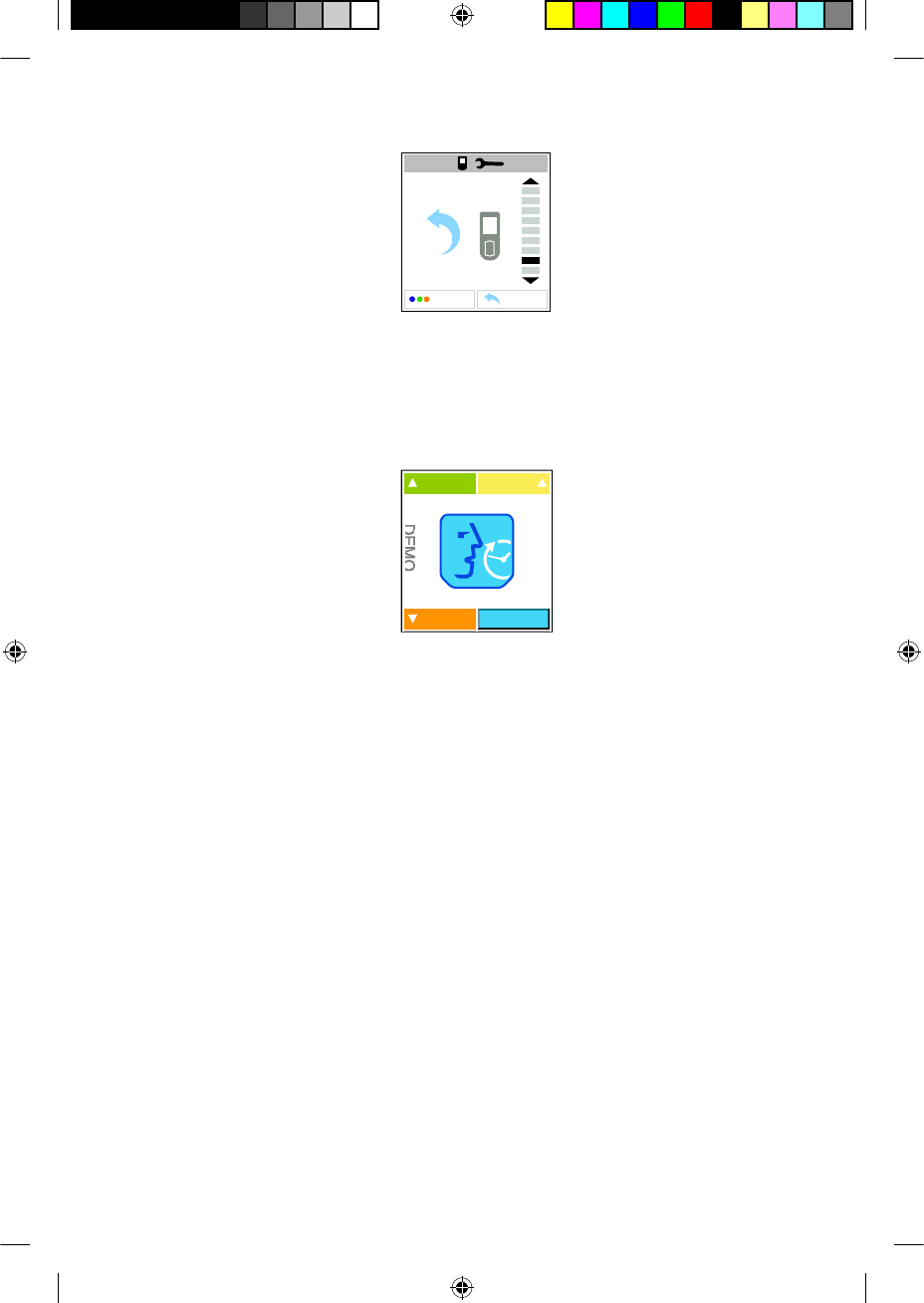
Reset
Reset
DEMO Reset
Figure 39: Remote assistant reset screen with Demo mode button
When using your remote assistant in Demo mode, all screens are
labelled Demo. You also see fl ashes of green, blue and orange indicator
lights on your remote assistant.
Noise
Music
Focus
Everyday
DEMO
DEMO
Figure 40: Demo mode Home screen
To stop using Demo mode, you can:
Reset your remote assistant by pressing the lower right soft key on •
the remote assistant reset screen.
Turn off your remote assistant and turn it back on.•
If you start pairing your remote assistant with your processor while in
Demo mode, you will exit Demo mode.
© Cochlear Limited 2009 CR110 User Guide - 37
Using your remote assistant
195993 Iss3 CR110 user guide 01.nu.indd 37 13/05/2009 5:12:26 PM
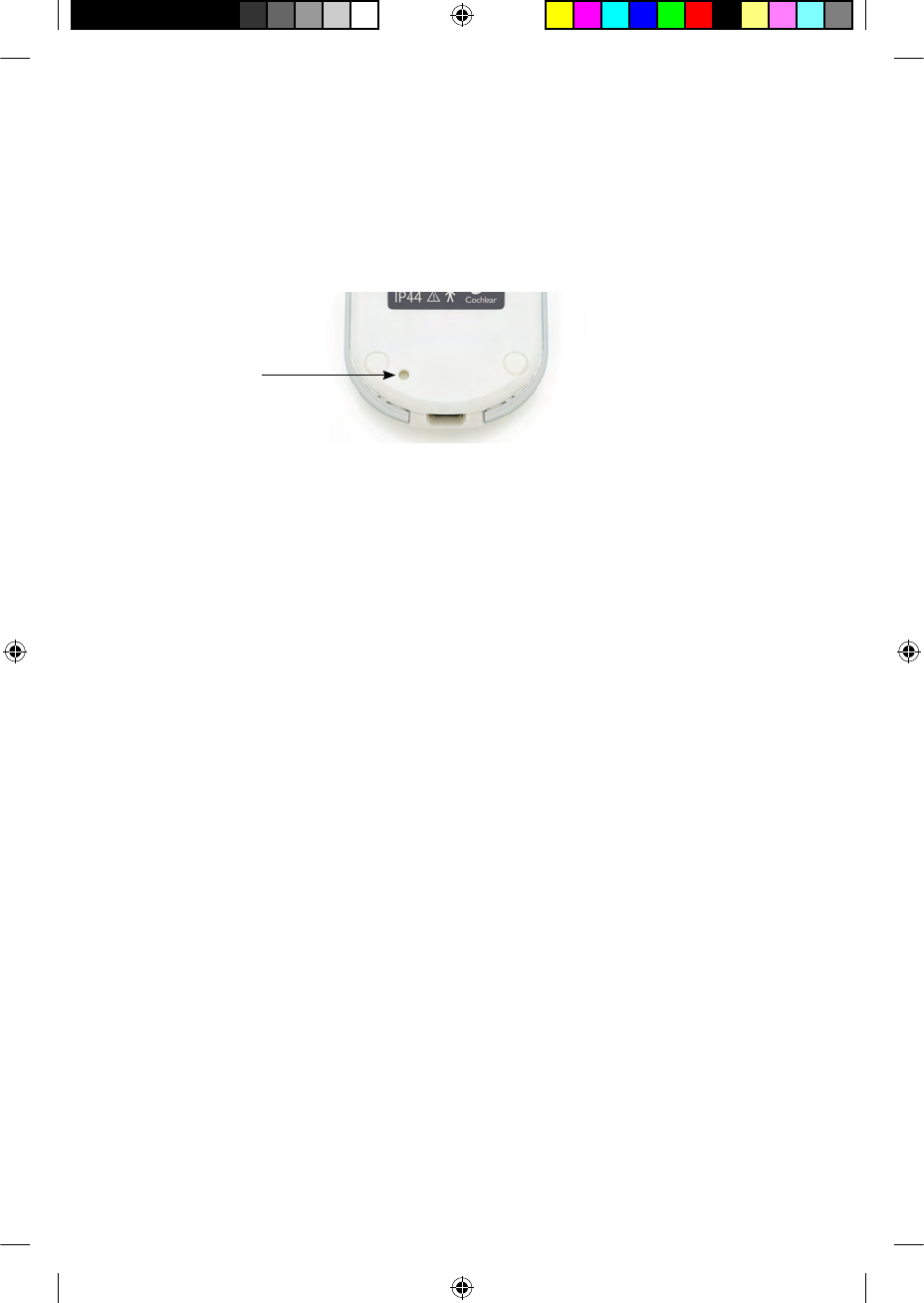
Using the Hard Reset button
If the Cochlear key does not work or your remote assistant display
freezes, you can press the Hard Reset button on the back of the remote
assistant to reset your remote assistant.
Figure 41: Hard reset button on the remote assistant
38 - CR110 User Guide © Cochlear Limited 2009
Using your remote assistant
195993 Iss3 CR110 user guide 01.nu.indd 38 13/05/2009 5:12:26 PM
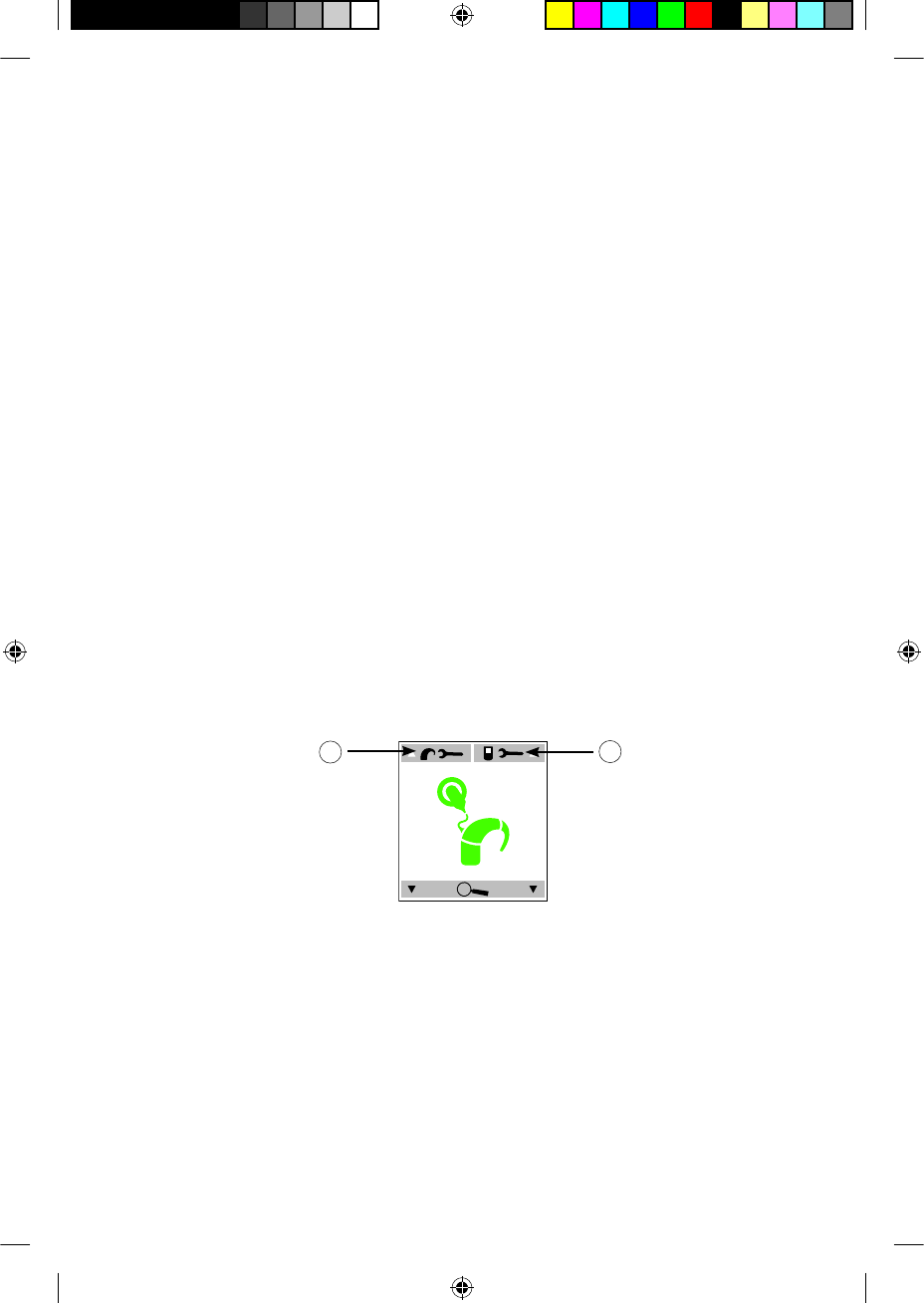
Personalising settings
You can use your remote assistant to personalise your processor
settings (e.g. change the processor microphone direction) to suit your
listening needs. You can change the processor settings only when the
processor is turned on and within operating distance. If the remote
assistant is paired with two processors, both processors need to be
turned on and within operating distance.
You can also personalise your remote assistant settings (e.g. change the
brightness of the remote assistant display).
If you accidentally change a processor setting, or you wish to return
to the default settings, you can easily reset processor and program
settings to the values set by your clinician. You can also reset remote
assistant settings to the default settings.
To personalise your processor or remote assistant settings:
Turn on your processor and ensure that it is within operating 1.
distance.
From the Home screen, press the Cochlear key.2.
To select the processor settings menu, press the upper left soft 3.
key. To select the remote assistant settings menu, press the upper
right soft key.
Figure 42: Processor settings menu (1) and remote assistant settings menu (2)
To select the processor or remote assistant setting you wish to 4.
change, press the lower directional key until the desired settings
screen displays.
Processor settings that you change apply to all programs, regardless of
the program that is selected. When the remote assistant is paired with
two processors, all processor settings apply to both processors.
2
1
© Cochlear Limited 2009 CR110 User Guide - 39
195993 Iss3 CR110 user guide 01.nu.indd 39 13/05/2009 5:12:33 PM
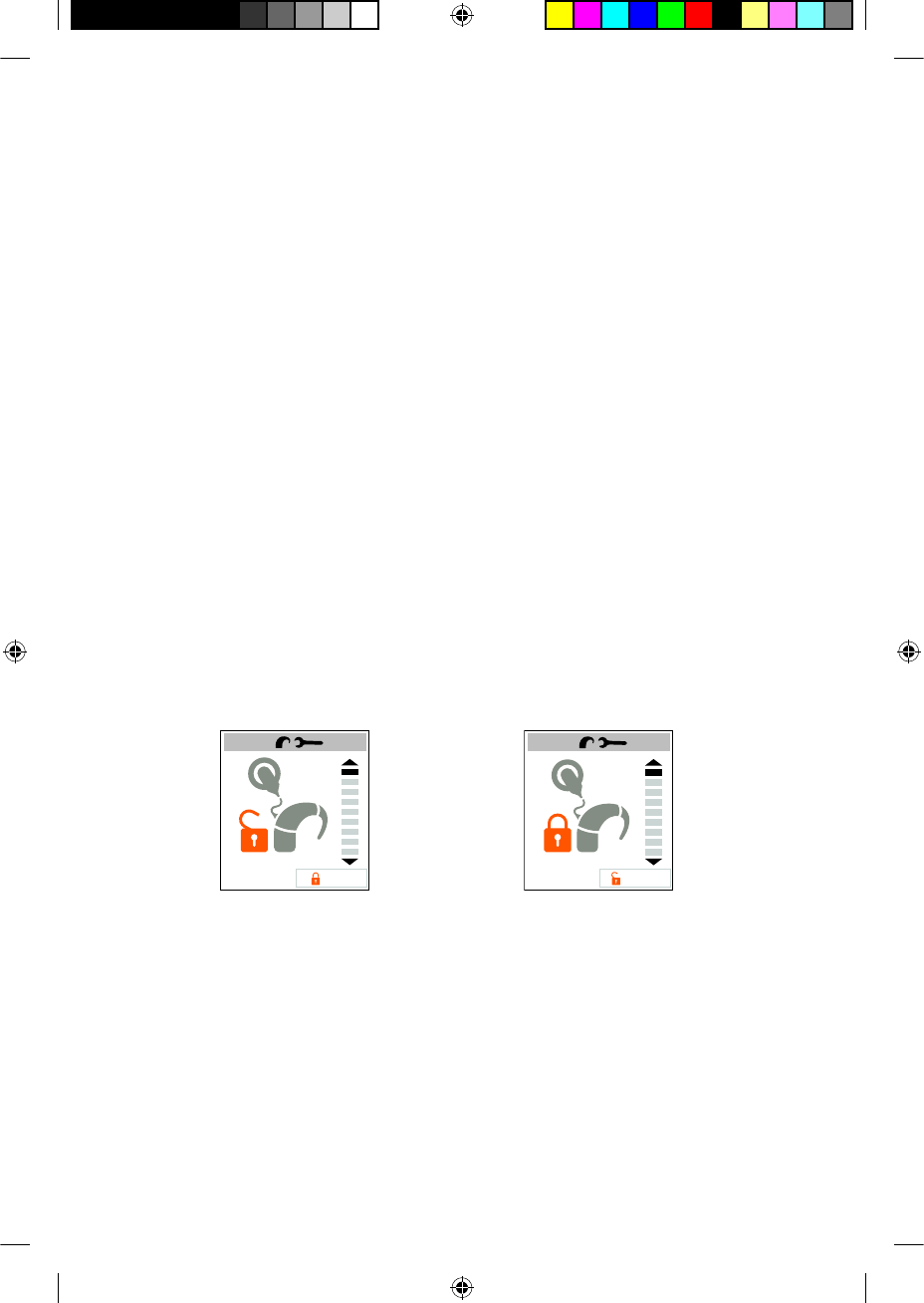
Personalising your processor settings
You can change the following processor settings:
Lock and unlock your processor buttons.•
Change the telecoil and microphone mixing ratio.•
Change the audio accessory and microphone mixing ratio.•
Set your processor indicator light preferences.•
Enable and disable private tones.•
Change the microphone direction.•
Reset all your processor and program settings.•
View your processor fi rmware and serial number details.•
Read the following sections for more information on changing these
settings.
Locking and unlocking your processor buttons
You can lock the two buttons on your processor to prevent children
from changing the settings, or to avoid accidental button presses
changing your processor settings.
Lock
Lock
Figure 43: Processor buttons unlocked
U nlock
U nlock
Figure 44: Processor buttons locked
To lock or unlock your processor buttons:
Select the processor buttons lock and unlock screen from the 1.
processor settings menu.
Press the lower right soft key to lock or unlock the processor 2.
buttons.
40 - CR110 User Guide © Cochlear Limited 2009
Personalising settings
195993 Iss3 CR110 user guide 01.nu.indd 40 13/05/2009 5:12:33 PM

Changing the telecoil and microphone mixing ratio
Mixing allows you to combine input from more than one audio input
source (e.g. telecoil and microphones).
The telecoil and microphone mixing ratio specifi es the ratio of the
telecoil input in relation to the microphone input.
To focus more on the telecoil input and reduce background sounds,
increase the mixing ratio. To hear more background sounds while using
the telecoil, decrease the mixing ratio.
You can set the mixing ratio for the telecoil and microphone to any of
the following:
1:1• (50% telecoil input: 50% microphone input).
2:1• (67% telecoil input: 33% microphone input).
3:1• (75% telecoil input: 25% microphone input).
4:1• (80% telecoil input: 20% microphone input).
5:1• (83% telecoil input: 17% microphone input).
6:1• (86% telecoil input: 14% microphone input).
100%• telecoil input.
When you set telecoil input to 100%, you see the letter 'T' on the
mixing ratio screen.
To increase or decrease the mixing ratio for the telecoil and microphone:
Select the telecoil and microphone mixing ratio screen from the 1.
processor settings menu.
To focus more on the telecoil input, press the lower left soft key. To 2.
hear more background sounds, press the lower right soft key.
T
Figure 45: Telecoil input set to 100%
© Cochlear Limited 2009 CR110 User Guide - 41
Personalising settings
195993 Iss3 CR110 user guide 01.nu.indd 41 13/05/2009 5:12:33 PM

Changing the audio accessory and microphone mixing ratio
The audio accessory and microphone mixing ratio specifi es the ratio of
audio accessory input in relation to microphone input.
To focus more on audio accessory input and reduce background sounds,
increase the mixing ratio. To hear more background sounds while using
audio accessories, decrease the mixing ratio.
You can set the mixing ratio for an audio accessory and the microphone
to any of the following:
1:1 • (50% audio accessory input: 50% microphone input).
2:1• (67% audio accessory input: 33% microphone input).
3:1• (75% audio accessory input: 25% microphone input).
4:1• (80% audio accessory input: 20% microphone input).
5:1• (83% audio accessory input: 17% microphone input).
6:1• (86% audio accessory input: 14% microphone input).
100%• audio accessory input.
When you set audio accessory input to 100%, you see the letter 'A' on
the mixing ratio screen.
To increase or decrease the mixing ratio for the audio accessory and
microphone:
Select the audio accessory and microphone mixing ratio screen 1.
from the processor settings menu.
To focus more on the audio accessory input, press the lower left 2.
soft key. To hear more background sounds, press the lower right
soft key.
A
Figure 46: Audio accessory input set to 100%
42 - CR110 User Guide © Cochlear Limited 2009
Personalising settings
195993 Iss3 CR110 user guide 01.nu.indd 42 13/05/2009 5:12:33 PM
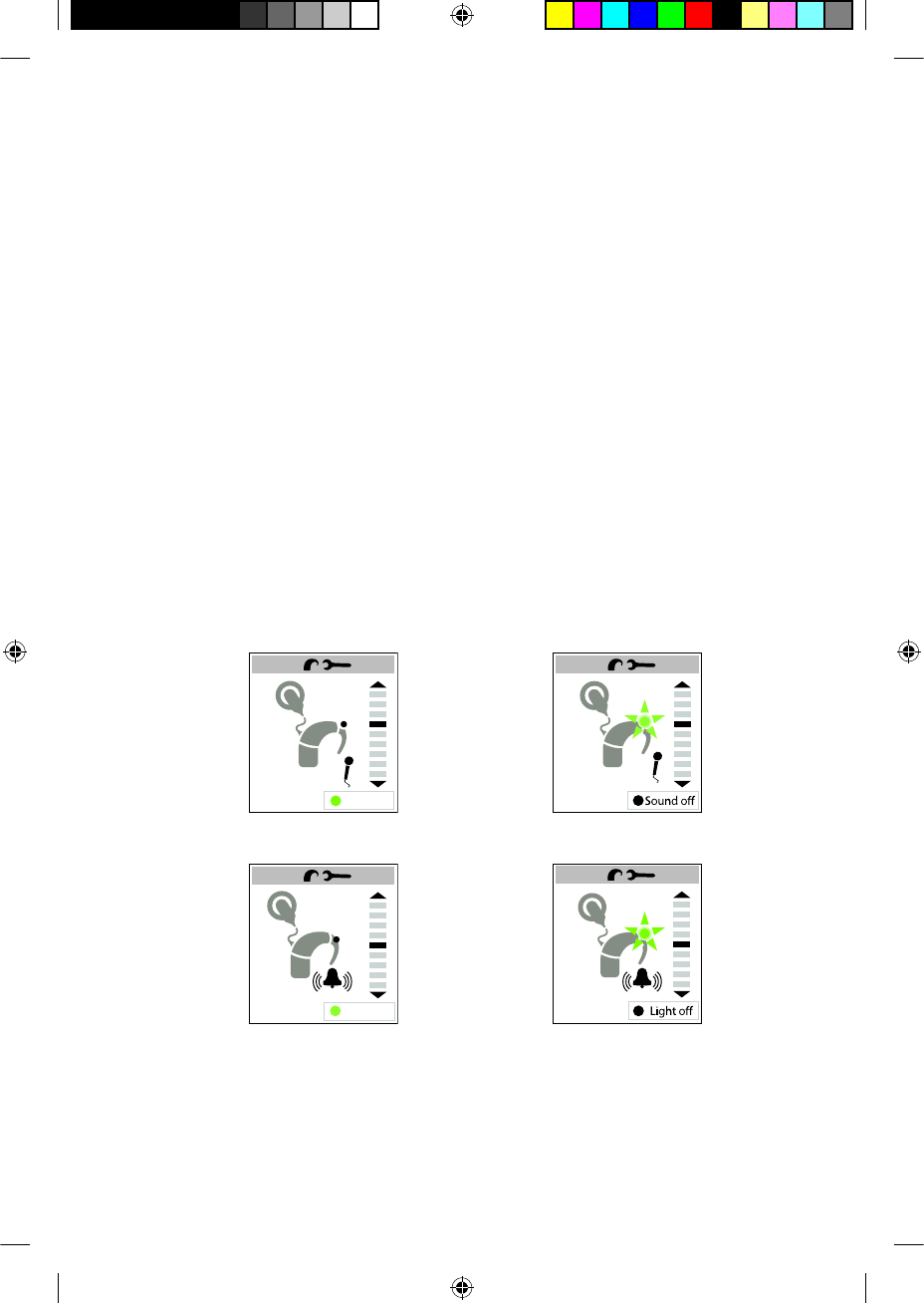
Setting your processor indicator light preferences
The indicator light on your processor provides a visual confi rmation
when you change a processor setting, or when there is a problem with
the processor.
The processor settings menu allows you to set your indicator light
preferences for your processor. For visual confi rmation of setting
changes (key presses) and processor problems (alerts), turn on Light.
For visual confi rmation that the processor is receiving sound, turn on
Sound. This visual confi rmation is useful if the recipient is a small child.
For discreet use of the processor without indicator lights, turn off both
Sound and Light.
To set the indicator light preferences:
Select the desired indicator light preferences screen (e.g. Sound on/1.
off screen) from the processor settings menu.
Press the lower right soft key to select your indicator light 2.
preference (e.g. to turn Sound on or off, press the lower right soft
key).
LED on
Sound on
Figure 47: Sound Ok light indicator is off
LED on
Figure 48: Sound Ok light indicator is on
Light on
Figure 49: Alert and key press light
indicator is off
Figure 50: Alert and key press light
indicator is on
© Cochlear Limited 2009 CR110 User Guide - 43
Personalising settings
195993 Iss3 CR110 user guide 01.nu.indd 43 13/05/2009 5:12:33 PM
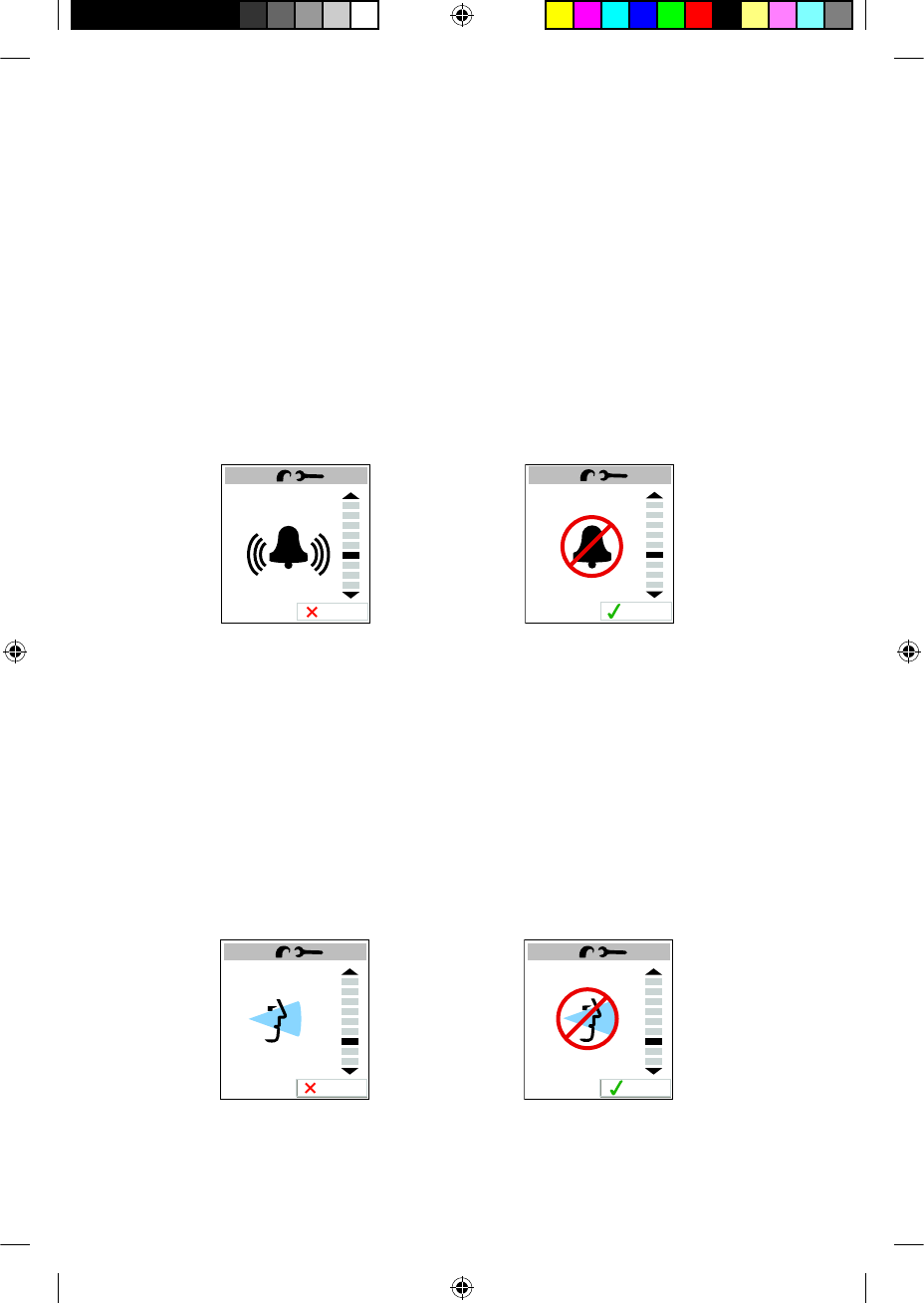
Enabling and disabling private tones
A private tone is a sound that only the recipient hears when a setting is
changed, or when there is a problem with the processor.
To hear a tone when a setting is changed, or when there is a problem,
enable processor private tones. For silent use, disable processor private
tones.
To enable or disable private tones:
Select the private tones screen from the processor settings menu.1.
Press the lower right soft key to enable or disable private tones.2.
Disable
Disable
Figure 51: Private tones enabled
Enable
Enable
Figure 52: Private tones disabled
Changing the microphone direction to Zoom
To hear sounds coming from the front and reduce sounds from other
directions, you can change the microphone direction to Zoom.
To enable Zoom:
Select the microphone direction screen from the processor 1.
settings menu.
To enable or 2. disable Zoom, press the lower right soft key.
Disable
Figure 53: Zoom enabled
Enable
Figure 54: Zoom disabled
44 - CR110 User Guide © Cochlear Limited 2009
Personalising settings
195993 Iss3 CR110 user guide 01.nu.indd 44 13/05/2009 5:12:34 PM

Resetting all your processor settings and programs
If you accidentally change a processor setting, or you wish to return to
your default settings, you can reset all processor and program settings
to the default settings.
To reset your processor settings and programs to the default settings:
Select the processor settings reset screen from the processor 1.
settings menu.
Press the lower right soft key to reset all processor settings and 2.
programs to the default settings. Once the settings are reset to the
default settings, the remote assistant confi rms that the settings
have been reset.
Reset
Reset
Figure 55: Processor settings reset screen
Figure 56:
Done
Done
Processor settings and programs have been reset
Viewing your processor fi rmware and serial number details
To view the details of your processor fi rmware and serial number, select
the processor fi rmware and serial number screen from the processor
settings menu.
© Cochlear Limited 2009 CR110 User Guide - 45
Personalising settings
195993 Iss3 CR110 user guide 01.nu.indd 45 13/05/2009 5:12:34 PM

L
R
Version No
872 SP15A
Version No
872 SP15B
Figure 57: Processor fi rmware and serial number details
Personalising your remote assistant settings
You can change the following remote assistant settings to suit your
needs:
Change your remote assistant display contrast.•
Change your remote assistant display brightness.•
Change your remote assistant speaker volume.•
Enable and disable your remote assistant audio and visual alerts.•
Select your remote assistant language.•
View your remote assistant fi rmware and serial number details.•
Read the following sections for more information on how to change
these settings.
Changing your remote assistant display contrast
Depending on the current lighting condition, you may want to change
your remote assistant display contrast. You can do this by increasing or
decreasing the contrast between light and dark images.
To change your remote assistant display contrast:
Select the remote assistant display contrast screen from the 1.
remote assistant settings menu.
To increase the contrast between dark and light images, press the 2.
lower left soft key. To decrease the contrast, press the lower right
soft key.
46 - CR110 User Guide © Cochlear Limited 2009
Personalising settings
195993 Iss3 CR110 user guide 01.nu.indd 46 13/05/2009 5:12:35 PM
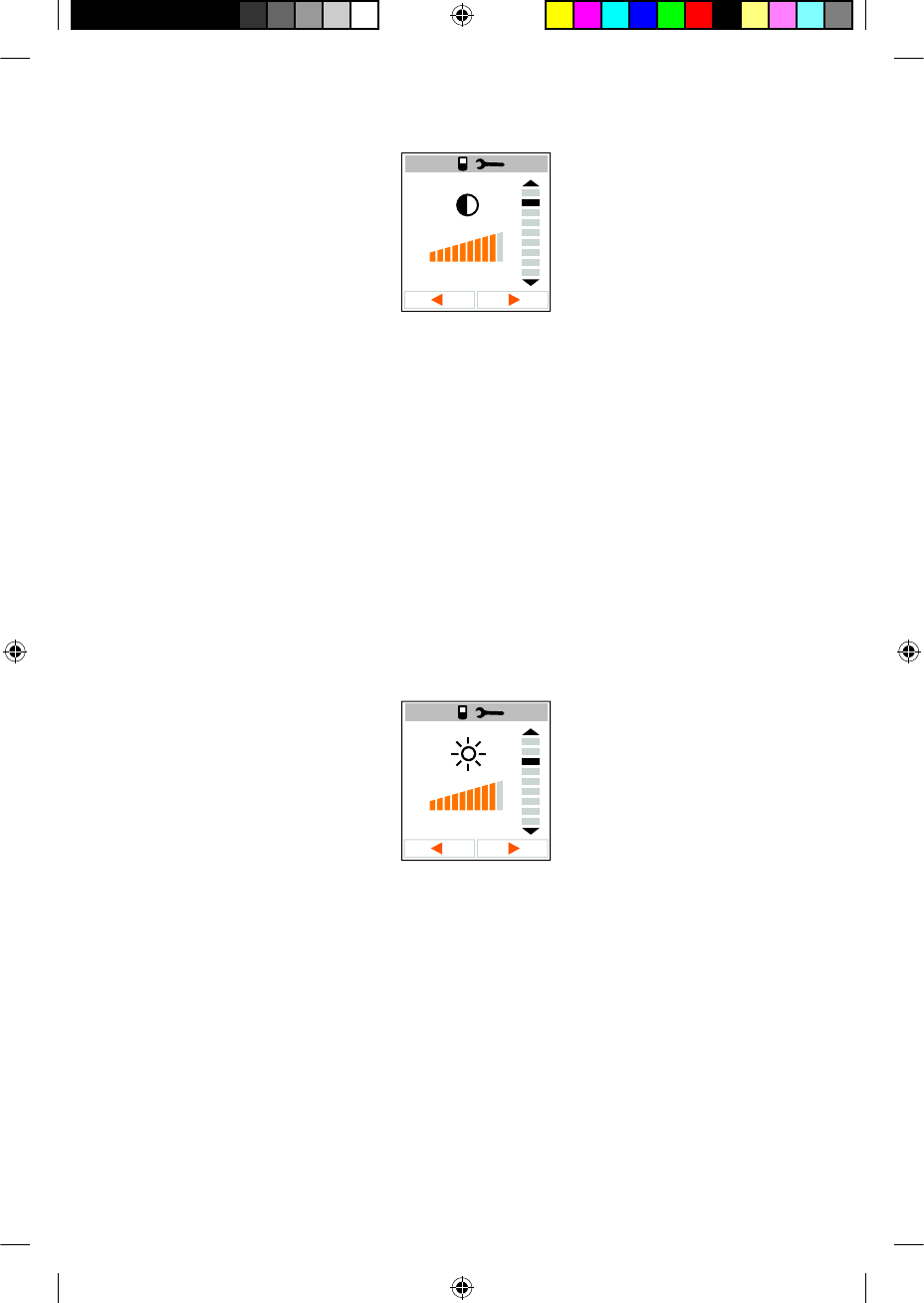
Figure 58: Remote assistant display contrast screen
Changing your remote assistant display brightness
Depending on the current lighting condition, you may want to change
your remote assistant display brightness. If there is a lot of light,
decrease the level of brightness. If there is poor light, increase the level
of brightness.
To change your remote assistant display brightness:
Select the remote assistant display brightness screen from the 1.
remote assistant settings menu.
To increase the level of brightness, press the lower right soft key. To 2.
decrease the level of brightness, press the lower left soft key.
Figure 59: Remote assistant display brightness screen
Changing your remote assistant speaker volume
Your remote assistant allows you to change the volume of the sounds
associated with visual alerts and key presses.
To change your remote assistant speaker volume:
Select the remote assistant speaker volume screen from the 1.
remote assistant settings menu.
© Cochlear Limited 2009 CR110 User Guide - 47
Personalising settings
195993 Iss3 CR110 user guide 01.nu.indd 47 13/05/2009 5:12:35 PM
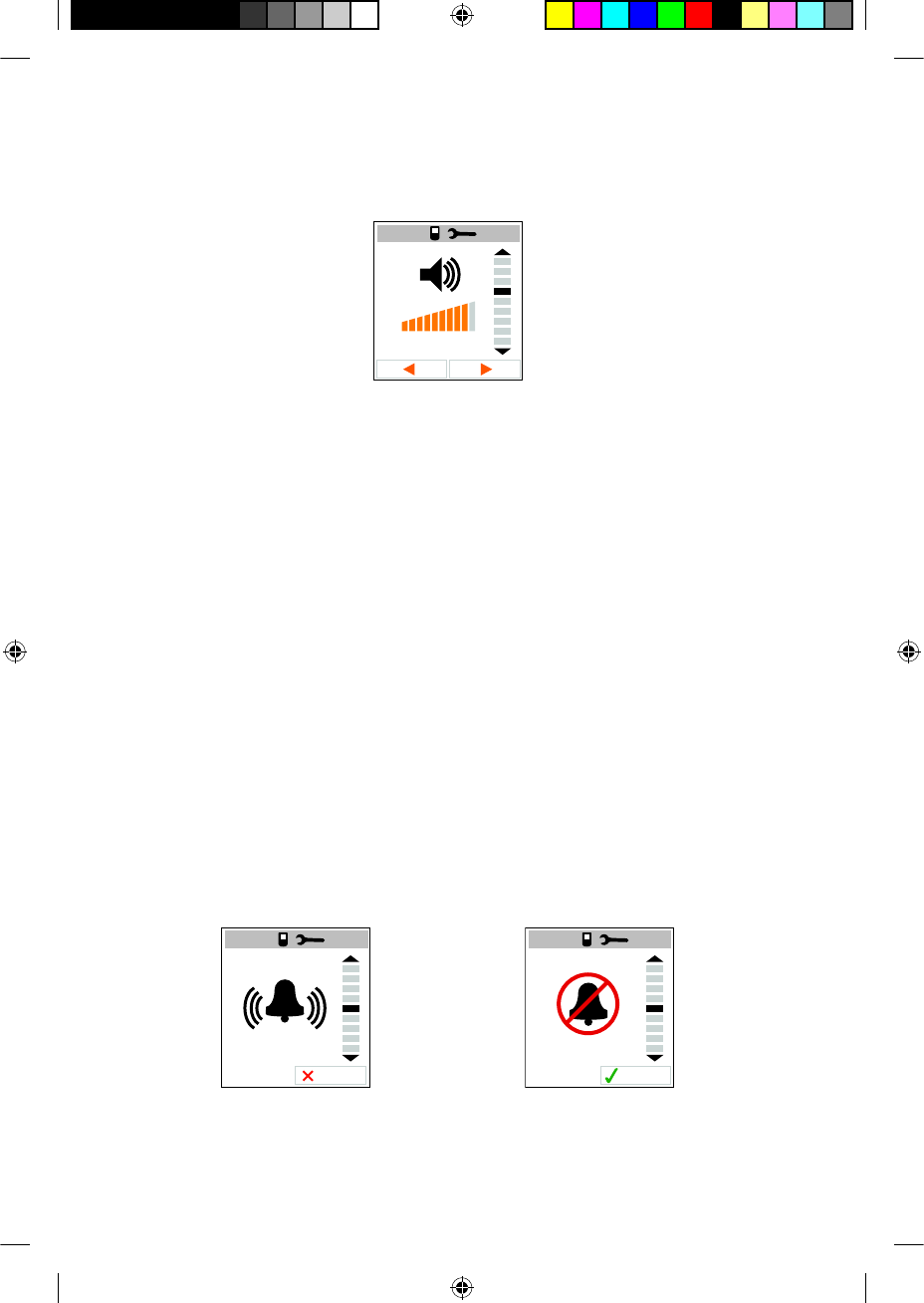
To increase the speaker volume, press the lower right soft key. To 2.
decrease the volume, press the lower left soft key.
Figure 60: Remote assistant speaker volume screen
Enabling and disabling audio and visual alerts
When your remote assistant visual alerts are enabled, an alert pops up
on your remote assistant display when there is a problem (e.g. when the
coil is off). You will also hear a sound.
If your remote assistant alerts are disabled, you will only see visual alerts
when you enter the processor status screen. To save battery power,
there are no visual alerts when your remote assistant is in standby
mode.
The orange indicator light will fl ash when there is a problem, even if
visual alerts are disabled.
To enable or disable your remote assistant audio and visual alerts:
Select the remote assistant audio and visual alerts screen from the 1.
remote assistant settings menu.
To enable or disable audio and visual alerts, press the lower right 2.
soft key.
Disable
Disable
Figure 61: Remote assistant visual alerts
and sounds enabled
Enable
Enable
Figure 62: Remote assistant visual alerts
and sounds disabled
48 - CR110 User Guide © Cochlear Limited 2009
Personalising settings
195993 Iss3 CR110 user guide 01.nu.indd 48 13/05/2009 5:12:35 PM
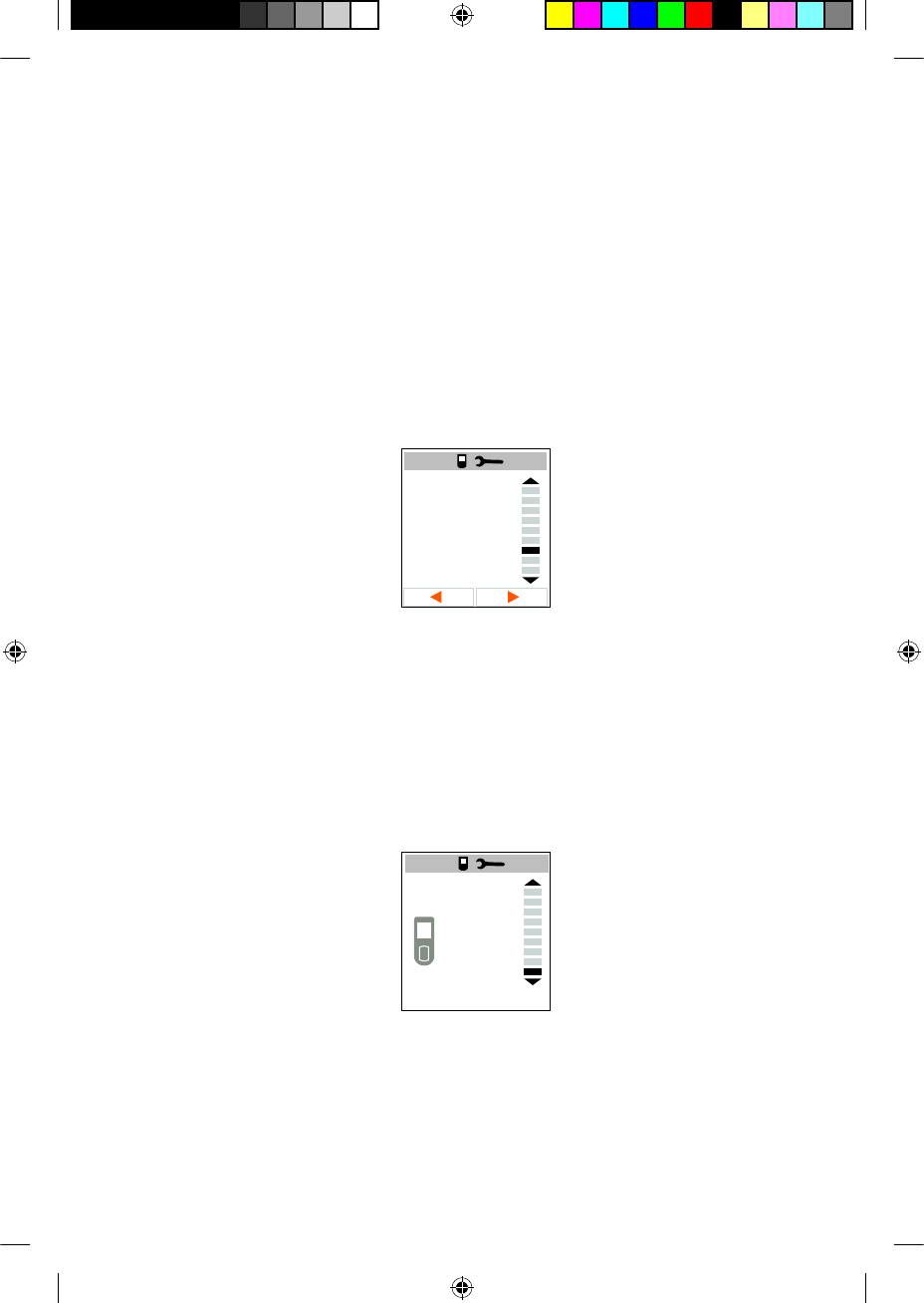
Selecting your remote assistant language
Your remote assistant is available in a number of different languages.
To select another language:
Select the remote assistant language selection screen from the 1.
remote assistant settings menu.
To select another language, press the lower left or lower right soft 2.
key.
To go back to the previous language, press the opposite key until that
language displays.
English
Figure 63: Remote assistant language selection screen
Viewing your remote assistant fi rmware and serial number
details
To view the details of your remote assistant fi rmware and serial number,
select the remote assistant fi rmware and serial number screen from the
remote assistant settings menu.
Serial No
8243740UHG
Version No
872 SP15
Figure 64: Remote assistant fi rmware and serial numbers
You can also use the left and right directional keys to perform
the functions described in this section.
© Cochlear Limited 2009 CR110 User Guide - 49
Personalising settings
195993 Iss3 CR110 user guide 01.nu.indd 49 13/05/2009 5:12:36 PM

50 - CR110 User Guide © Cochlear Limited 2009
195993 Iss3 CR110 user guide 01.nu.indd 50 13/05/2009 5:12:36 PM
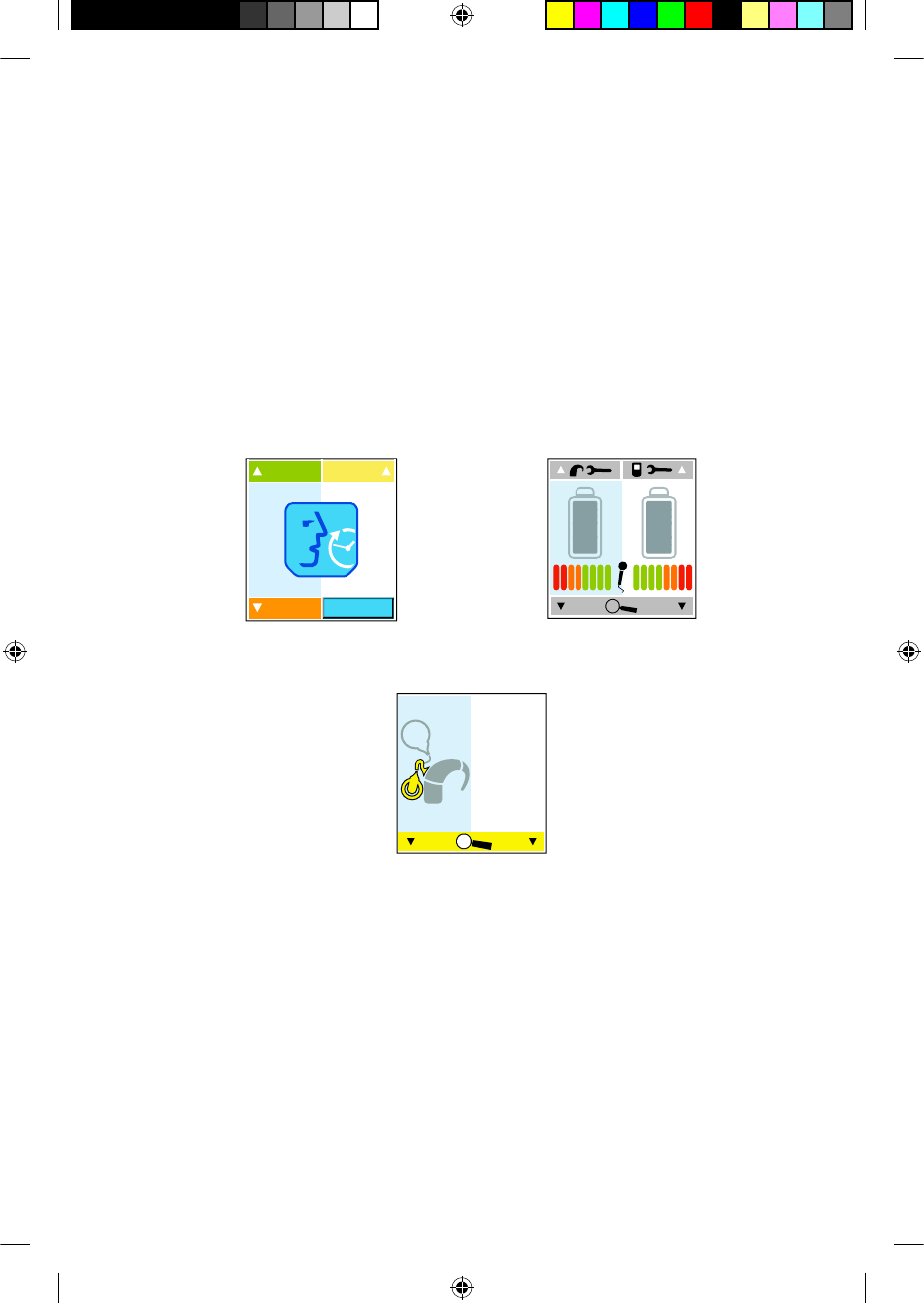
Bilateral control
If you have two (bilateral) implants, you can pair your remote assistant
with two processors. This allows you to control both processors at the
same time.
When your remote assistant is paired with two processors, the remote
assistant display is divided vertically in two on the following screens:
• Home screen.
Status screens.•
Visual alerts screen. •
Noise
Music
Focus
Everyday
Figure 65: Bilateral mode Home screen Figure 66: Bilateral mode processor
battery status screen
Figure 67: Bilateral mode visual alerts screen
© Cochlear Limited 2009 CR110 User Guide - 51
195993 Iss3 CR110 user guide 01.nu.indd 51 13/05/2009 5:12:36 PM
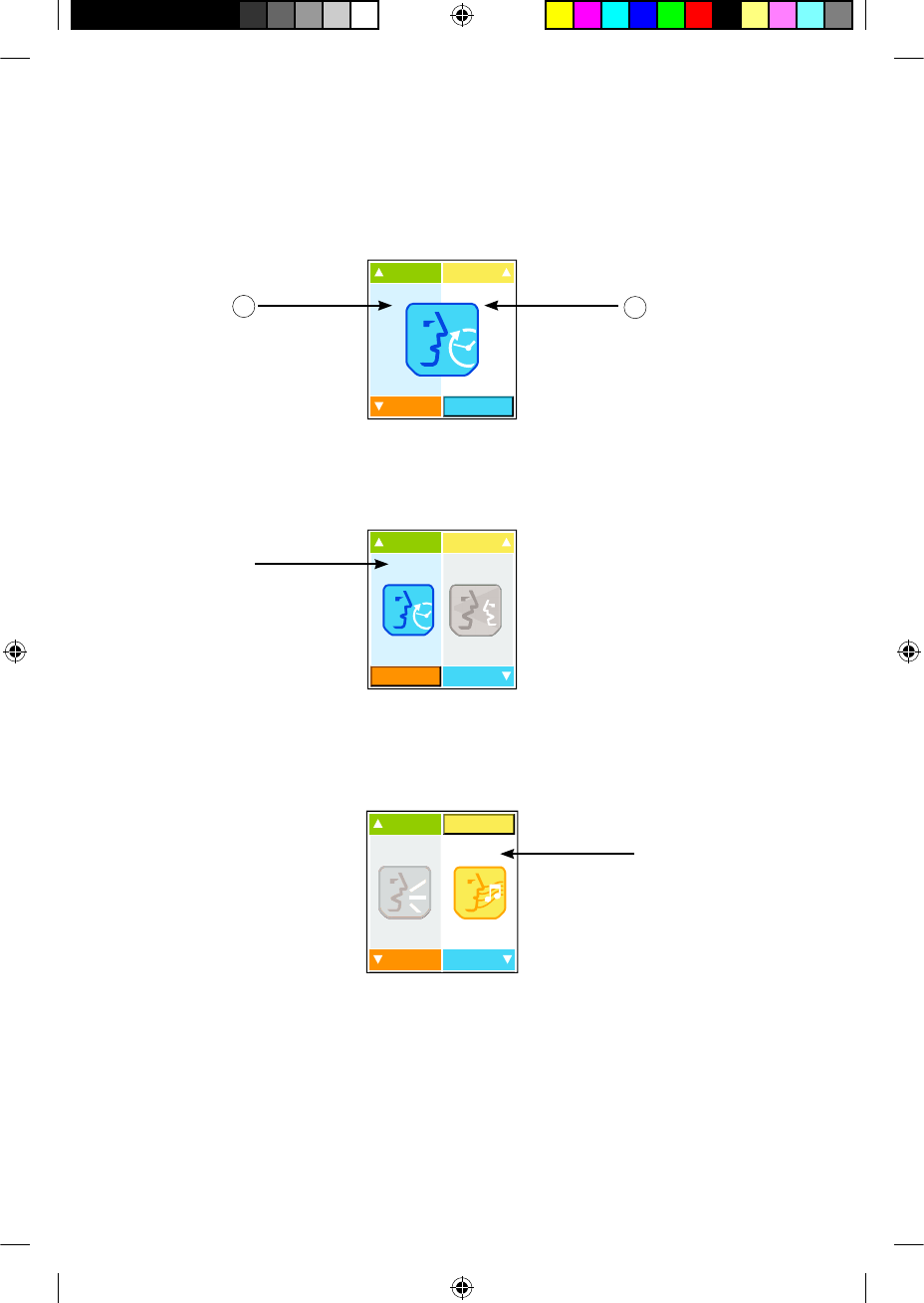
From the Home screen, you can choose one of three bilateral control
modes:
Dual control mode controls both processors.•
Noise
Music
Focus
Everyday
Figure 68: Bilateral control mode dual left side (1) and right side (2)
Left control mode controls only your left processor.•
Noise
Music
Focus
Everyday
Figure 69: Bilateral control mode left side
Right control mode controls only your right processor.•
Noise
Music
Focus
Everyday
Figure 70: Bilateral control mode right side
2
1
52 - CR110 User Guide © Cochlear Limited 2009
Bilateral control
195993 Iss3 CR110 user guide 01.nu.indd 52 13/05/2009 5:12:36 PM
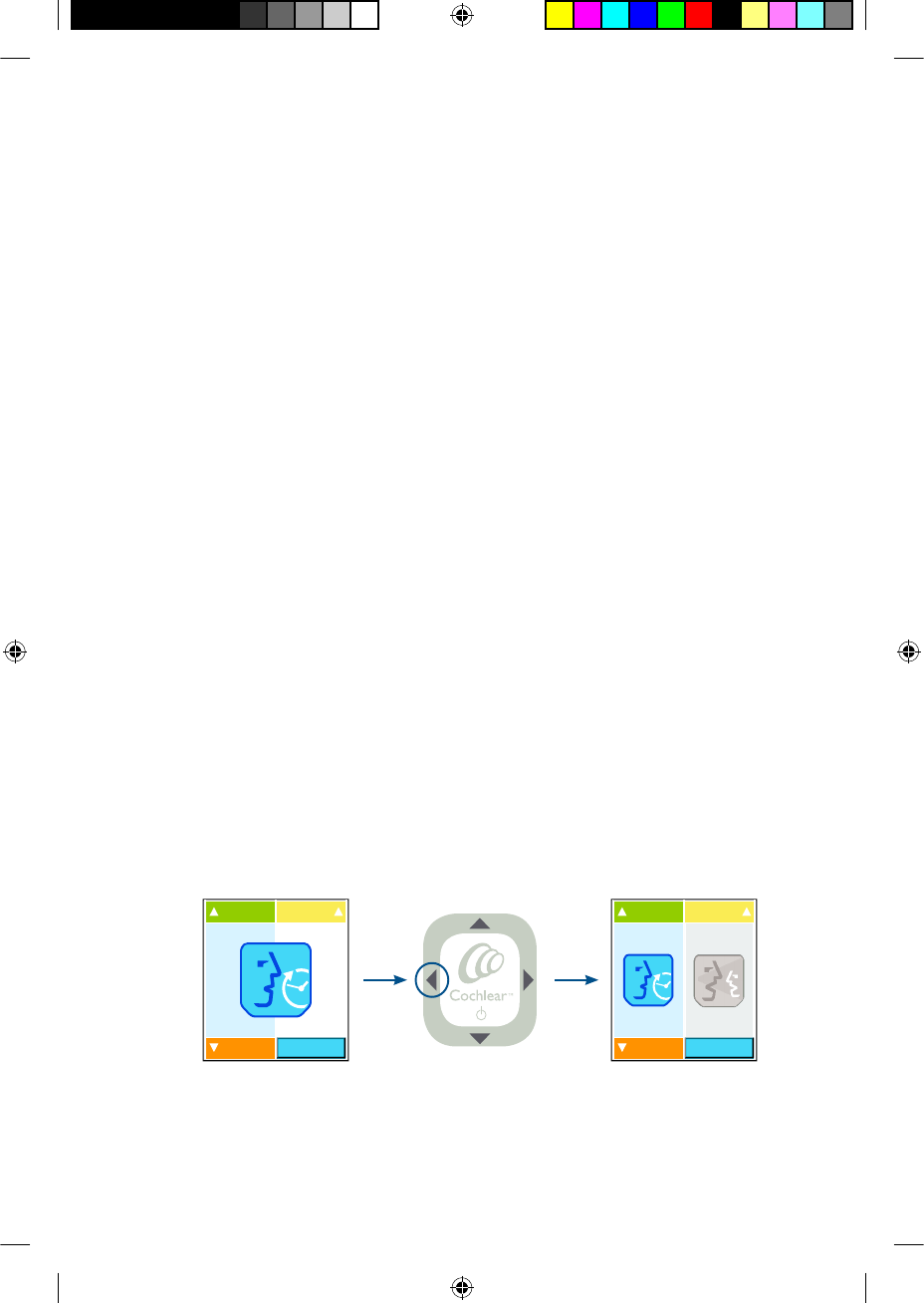
Dual control mode
When you pair two processors, your remote assistant is automatically
in dual control mode.
In dual control mode, you can control both processors at the same
time to:
Change programs.•
Change volume or sensitivity.•
Turn on the telecoil or Auto Telecoil.•
Connect an audio accessory.•
To change these settings, both processors must be on and your remote
assistant must be within operating distance of your processors.
Changes to processor settings (e.g. microphone direction) affect both
processors, regardless of the control mode.
Right or left control modes
Sometimes you may want to change a setting on one processor only.
For example:
Turn on the telecoil or Auto Telecoil on the left processor only.•
Change the volume or sensitivity on the right processor only.•
Switching between control modes
To switch between control modes, press and hold the left or right
directional key.
Noise
Music
Focus
Everyday Noise
Music
Focus
Everyday
Figure 71: Switching from dual control mode to left control mode
© Cochlear Limited 2009 CR110 User Guide - 53
Bilateral control
195993 Iss3 CR110 user guide 01.nu.indd 53 13/05/2009 5:12:37 PM
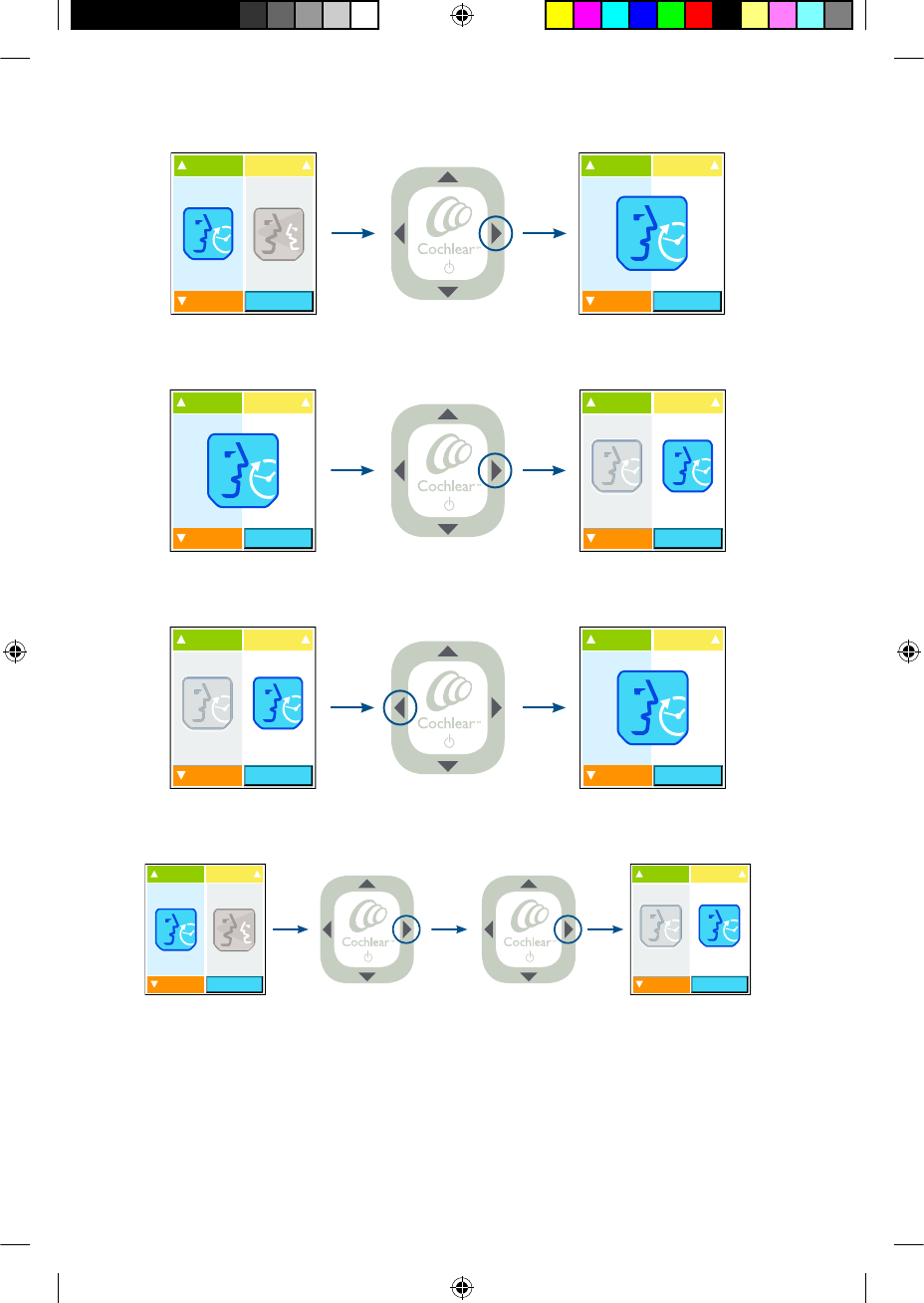
Noise
Music
Focus
EverydayNoise
Music
Focus
Everyday
Figure 72: Switching from left control mode to dual control mode
Noise
Music
Focus
Everyday Noise
Music
Focus
Everyday
Figure 73: Switching from dual control mode to right control mode
Noise
Music
Focus
EverydayNoise
Music
Focus
Everyday
Figure 74: Switching from right control mode to dual control mode
Noise
Music
Focus
Everyday Noise
Music
Focus
Everyday
Figure 75: Switching from left control mode to right control mode
54 - CR110 User Guide © Cochlear Limited 2009
Bilateral control
195993 Iss3 CR110 user guide 01.nu.indd 54 13/05/2009 5:12:37 PM
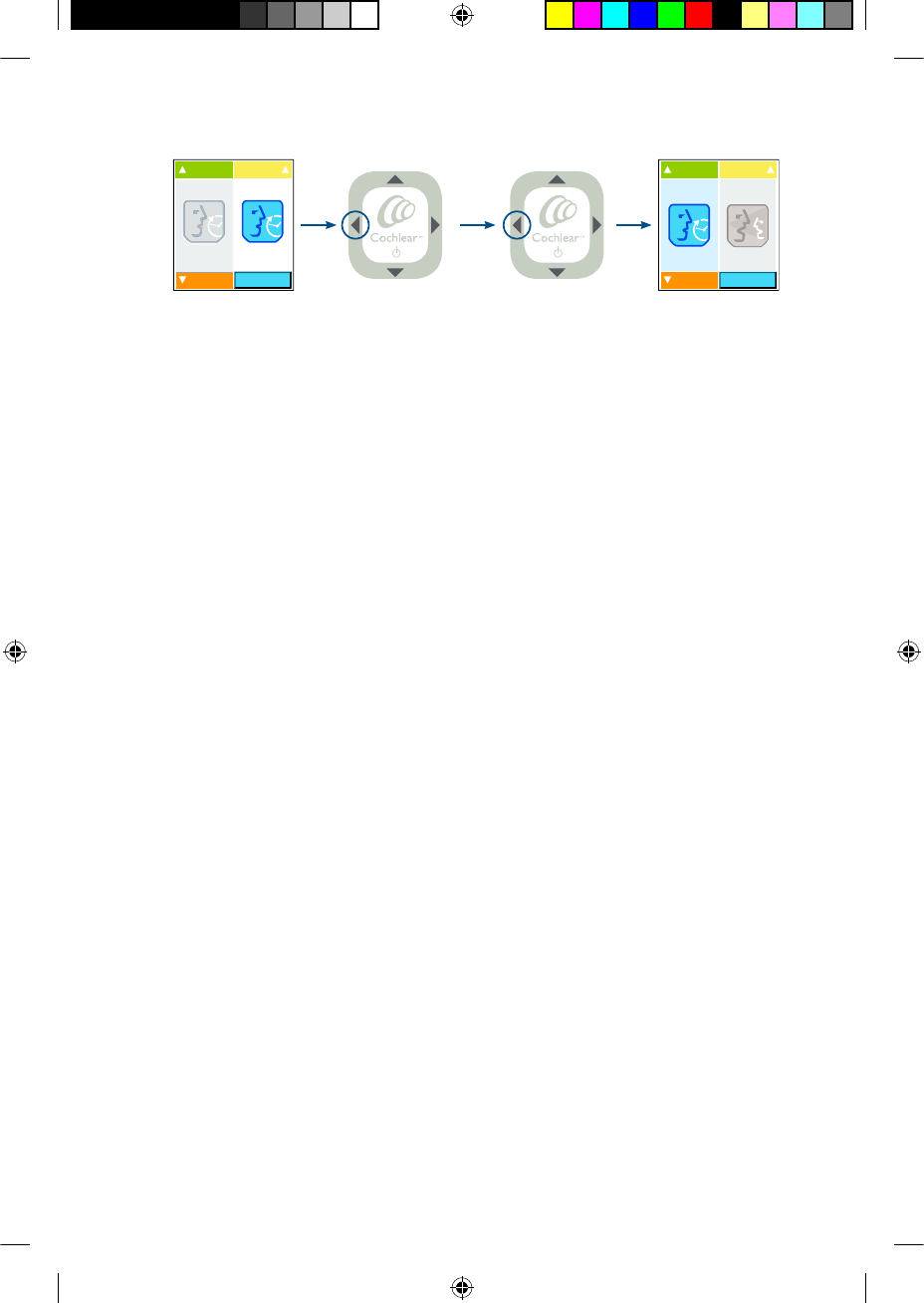
Noise
Music
Focus
EverydayNoise
Music
Focus
Everyday
Figure 76: Switching from right control mode to left control mode
© Cochlear Limited 2009 CR110 User Guide - 55
Bilateral control
195993 Iss3 CR110 user guide 01.nu.indd 55 13/05/2009 5:12:38 PM

56 - CR110 User Guide © Cochlear Limited 2009
195993 Iss3 CR110 user guide 01.nu.indd 56 13/05/2009 5:12:38 PM
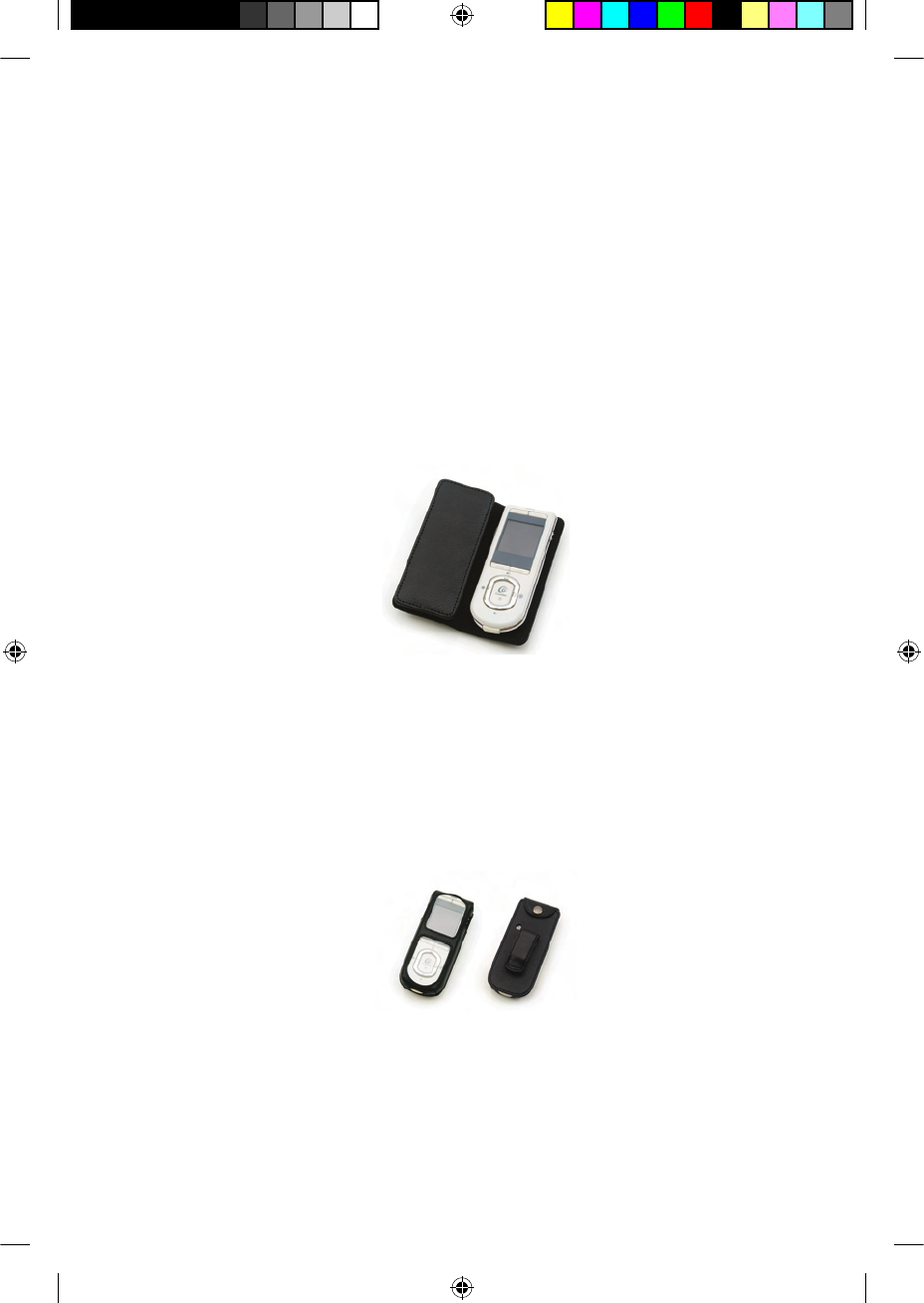
Caring for your remote assistant
Protecting your remote assistant
To protect your remote assistant against impact and scratches, Cochlear
recommends that you use a protective case. The following protective
cases are available from Cochlear:
• Cochlear™ Nucleus® CR100 Series Belt Case: You can insert the
remote assistant into the belt case and attach it to your belt. The
belt case can be rotated to adjust its position on the belt. When
you want to use your remote assistant, remove it from the belt
case.
Figure 77: Remote assistant belt case
• Cochlear™ Nucleus® CR100 Series Leather Case: The leather case
provides you with the fl exibility of either attaching the remote
assistant to your belt, or carrying it in your handbag or pocket. You
can use and charge the remote assistant while it is in the leather
case.
Figure 78: Remote assistant leather case
© Cochlear Limited 2009 CR110 User Guide - 57
195993 Iss3 CR110 user guide 01.nu.indd 57 13/05/2009 5:12:38 PM
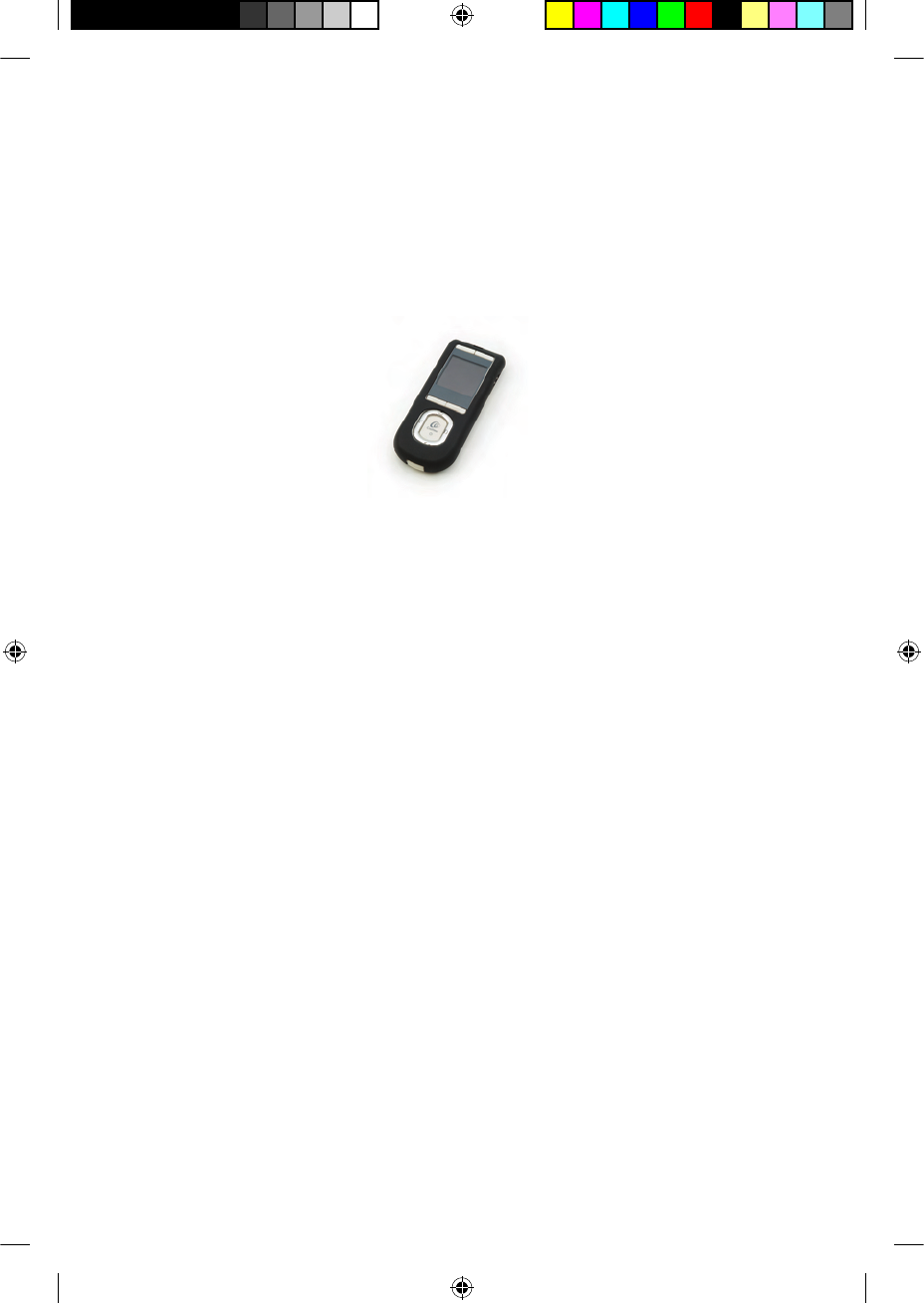
• Cochlear™ Nucleus® CR100 Series Protective Case: This is a fl exible
rubber case into which you can insert the remote assistant. It is
suitable for use by both children and adults, and is available in a
choice of colours. The protective case can be worn around the
neck using the remote assistant lanyard. You can use and charge
the remote assistant while it is in the protective case.
Figure 79: Protective case
When using the remote assistant while it is in a protective case,
you may notice a slight decrease in the operating range. If this
happens, either remove the remote assistant from the case when
using it, or hold the case close to your processor.
When the remote assistant is attached to your belt, certain
arm positions (e.g. arm swinging past the belt when walking)
may affect communication. If this happens, remove the remote
assistant from the case when using it.
Using the remote assistant lanyard
The Cochlear™ Nucleus® CR100 Series Lanyard allows you to wear the
remote assistant around your neck.
You can attach the lanyard to the remote assistant using the hole
located on the back of the remote assistant. When threading the
lanyard, always insert the lanyard loop through the bottom hole, which
is the hole just above the personal identifi cation label.
58 - CR110 User Guide © Cochlear Limited 2009
Caring for your remote assistant
195993 Iss3 CR110 user guide 01.nu.indd 58 13/05/2009 5:12:51 PM
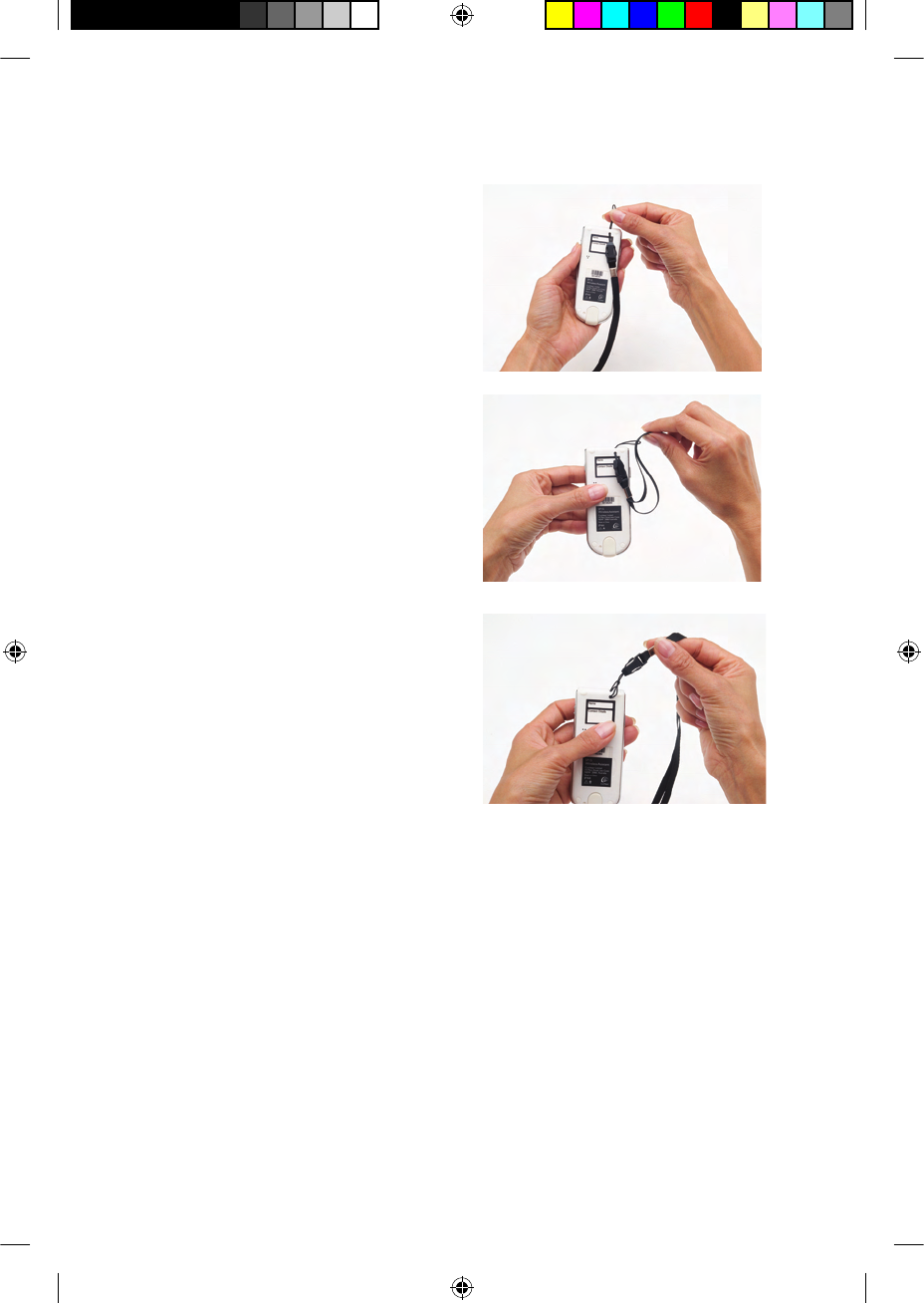
Thread the lanyard as shown below:
Hold the remote assistant in 1.
one hand.
Insert the lanyard loop 2.
through the bottom hole
with the thumb and index
fi nger of the other hand.
Insert the lanyard strap 3.
through the lanyard loop as
shown.
Pull the lanyard strap 4.
upwards until the loop
tightens into a knot.
Protecting your remote assistant from water
damage
Your remote assistant is protected against access of solid foreign objects
greater than or equal to 1.0 mm diameter, and failure from splashing
water (IP44 rating).
© Cochlear Limited 2009 CR110 User Guide - 59
Caring for your remote assistant
195993 Iss3 CR110 user guide 01.nu.indd 59 13/05/2009 5:12:55 PM
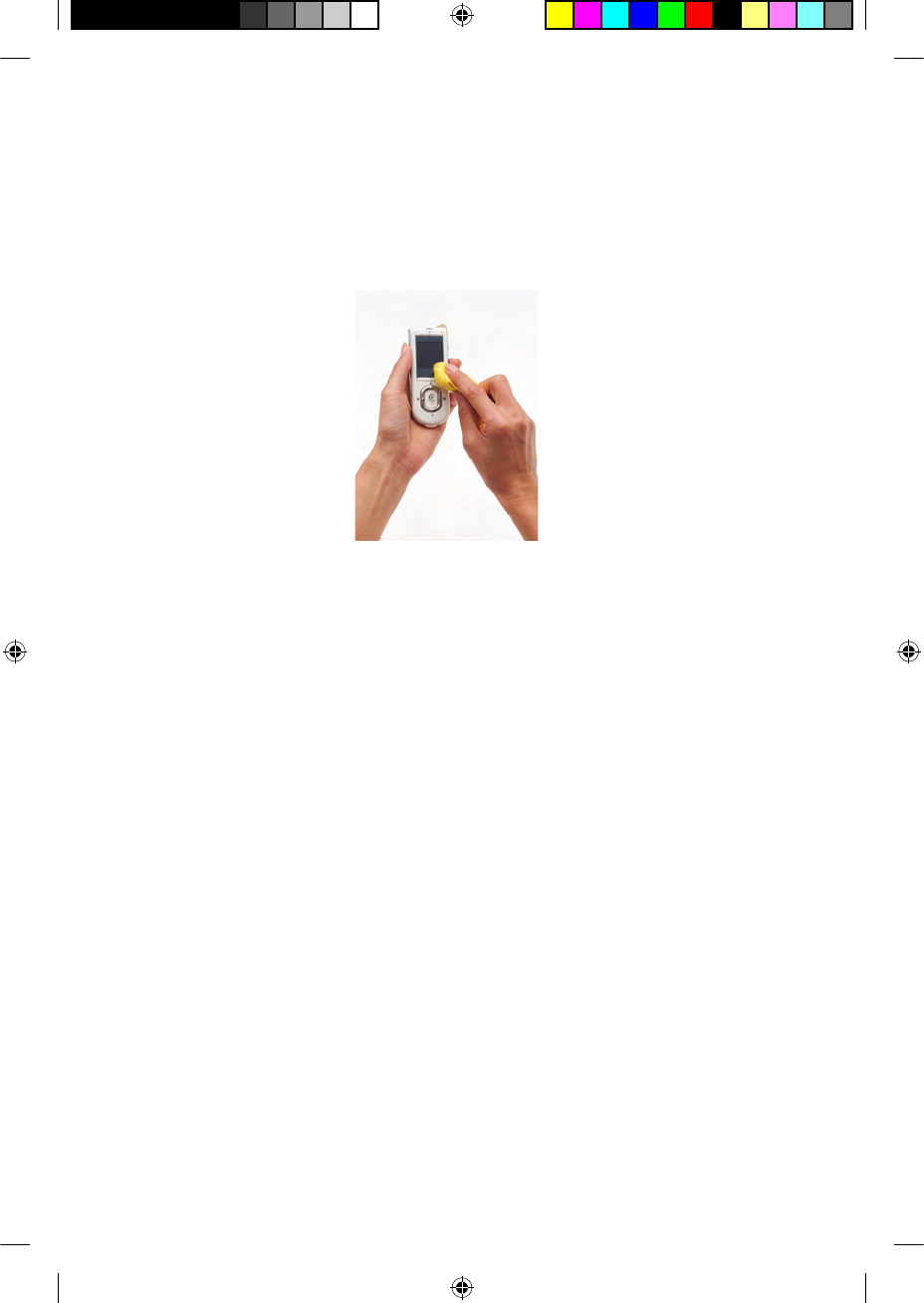
Cleaning your remote assistant
To keep your remote assistant clean, wipe its display and buttons with
a soft dry cloth. Do not use alcohol, household cleaners or abrasive
materials to clean your remote assistant.
Figure 80: Wiping the remote assistant with a soft dry cloth
If your belt case, leather case or protective case gets dirty, wipe it with a
soft dry cloth.
If your remote assistant gets wet:
Turn your remote assistant off.1.
Wipe it with a soft dry cloth.2.
Dry your remote assistant for approximately 12 hours. It is not 3.
recommended to use the Zephyr dry aid kit supplied with your
processor to dry your remote assistant. Do not use an oven or
microwave to dry your remote assistant.
To check if your remote assistant is still functioning, turn it on again
after it is dry. If your remote assistant no longer functions, return it to
your clinician. Cochlear cannot guarantee that it can repair a water-
damaged remote assistant.
60 - CR110 User Guide © Cochlear Limited 2009
Caring for your remote assistant
195993 Iss3 CR110 user guide 01.nu.indd 60 13/05/2009 5:13:17 PM

General warnings and precautions for using your
remote assistant
Using your remote assistant cables in any way contradictory to •
their intended purpose (e.g. wearing the USB cable around the
neck) can cause injury.
When operating machinery, ensure that your remote assistant •
lanyard does not get caught in the machine.
If your remote assistant becomes unusually warm, stop using it •
immediately and seek advice from your clinician.
Do not operate your remote assistant while driving.•
Do not leave your remote assistant in very hot areas (e.g. in direct •
sunlight, behind a window, in a car, etc.).
Avoid placing your remote assistant in environments where •
excessive moisture and dirt can damage it (e.g. swimming pools).
Be careful when placing your remote assistant in a bag or pocket •
with other objects as the display may scratch. You may want to
use commercially available protective fi lms to protect the remote
assistant display from scratches.
When charging your remote assistant from mains power, only •
use the CR100 Series Global Power Adaptor, or the CP800 Series
Global Power Adaptor (if using the CP800 Series Battery Charger).
Do not use excessive force when connecting your remote assistant •
to the remote assistant USB cable.
Avoid applying unnecessary pressure to the display, keypad or back •
of your remote assistant.
Avoid bending your remote assistant in any way. •
Do not attempt to open or dismantle your remote assistant. If the •
remote assistant is not working, return it to your clinician.
When your remote assistant is not in use, turn it off and store it •
safely.
Dispose of electrical components in accordance with your local •
regulations.
© Cochlear Limited 2009 CR110 User Guide - 61
Caring for your remote assistant
195993 Iss3 CR110 user guide 01.nu.indd 61 13/05/2009 5:13:24 PM

62 - CR110 User Guide © Cochlear Limited 2009
195993 Iss3 CR110 user guide 01.nu.indd 62 13/05/2009 5:13:24 PM
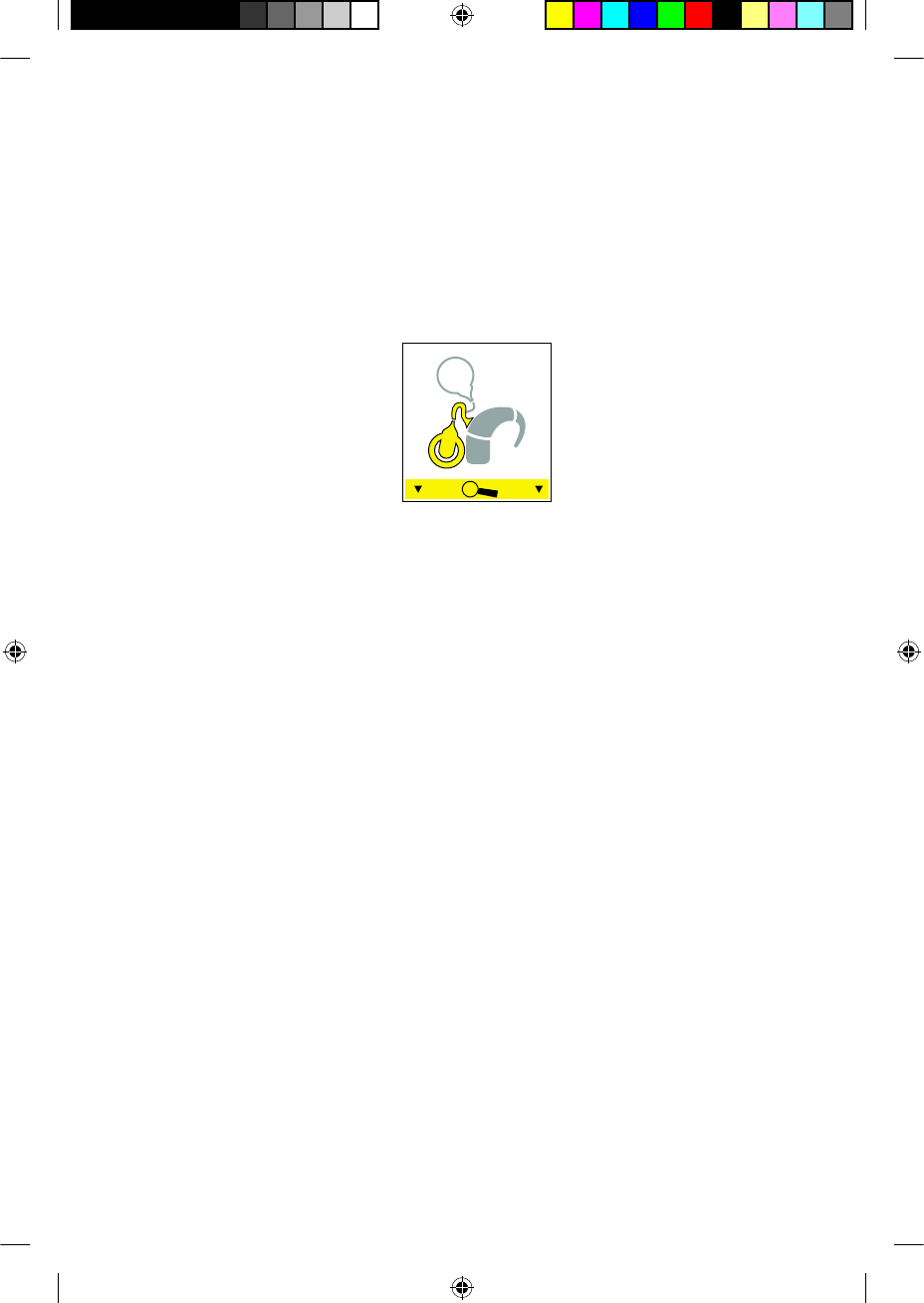
Using your remote assistant to
troubleshoot your processor
The following features on your remote assistant can help you
troubleshoot your processor:
Visual alerts that appear on your remote assistant display.•
Figure 81: Coil off visual alert
Your processor status indicator.•
The processor troubleshooting guide on your remote assistant.•
For information on how to troubleshoot your processor, refer to
the CP810 and CR110 Troubleshooting Guide provided with your
processor documentation.
Checking your processor coil
Your remote assistant has an in-built coil sensor that allows you to
check if the coil connected to your processor is receiving sound signals
from your processor.
To check the coil using the coil sensor:
Remove the coil from the head. Do not use the coil sensor when 1.
the coil is on the head.
Place the coil on the coil sensor guides on the back of your 2.
remote assistant. The coil sensor guides are located on the
sides of the product information label. Make sure that the coil is
properly aligned with the coil sensor guides.
© Cochlear Limited 2009 CR110 User Guide - 63
195993 Iss3 CR110 user guide 01.nu.indd 63 13/05/2009 5:13:24 PM
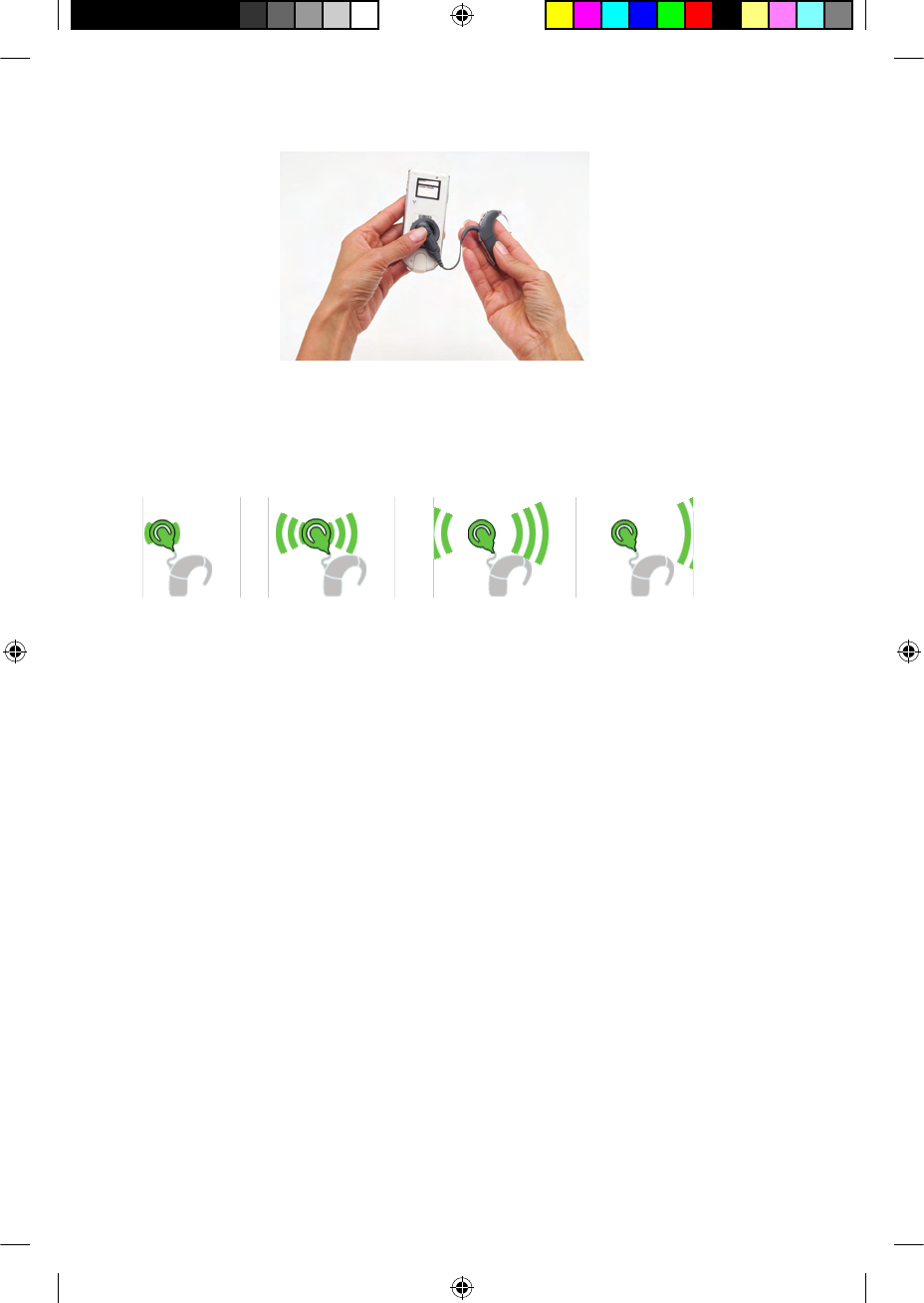
Figure 82: Placing the coil on the coil sensor guides
If the coil is receiving sound signals from your processor, the
following animation appears on your remote assistant display:
Figure 83: Coil sensor animation
This, however, is only an indication that the coil is receiving sound
signals and does not confi rm that the coil is functioning properly.
If the coil is not receiving sound signals, no response is shown on
your remote assistant display.
Once you move the coil away from your remote assistant, the
remote assistant returns to its previous display.
64 - CR110 User Guide © Cochlear Limited 2009
Using your remote assistant to troubleshoot your processor
195993 Iss3 CR110 user guide 01.nu.indd 64 13/05/2009 5:13:25 PM

Other information
Your warranty and registration form
Your warranty is included in the document pack you received with your
processor.
Please complete the registration form and return to Cochlear within 30
days of receiving the product.
Technical information
The remote assistant wireless communication link operates in the 2.4
GHz ISM band using GFSK (Gaussian Frequency Shift Keying) on 10
channels. The link uses a proprietary bi-directional communication
protocol and operates over a distance of up to 2m from the CP810
processor. When interference is present, the wireless communication
link switches between the 10 channels to fi nd a channel where the
interference least affects the operation of the link. The remote assistant
indicates via its display and light indicator when the processor is not
within operating distance, and when the link has been interrupted due
to interference. For more information, see Holding and operating your
remote assistant in this user guide.
Specifi cations
Physical confi guration
The remote assistant comprises:
Custom analogue and digital integrated circuits based on a micro-•
processor design, with bi-directional wireless communication
capabilities.
Push-buttons/keys and a slider for control of processor features •
and its own system features.
A display for indicating system status and activity.•
A speaker for sounding an audible alert.•
In-built coil sensor to check if the processor’s coil is receiving •
sound signals from the processor.
An indicator light for visual indication of system function or alert.•
On-board battery charging circuit.•
© Cochlear Limited 2009 CR110 User Guide - 65
195993 Iss3 CR110 user guide 01.nu.indd 65 13/05/2009 5:13:32 PM

A temperature sensor for battery safety.•
A mini type B USB connector for charging the device.•
Materials
The remote assistant housing, including non-metallic buttons/keys,
is made of polycarbonate. The spine and metallic buttons/keys are
made of chrome plated stainless steel.
Dimensions
Length Width Depth
110 mm 45 mm 12 mm
Weight
The remote assistant weighs approximately 64 g.
Operating characteristics
Characteristic Range
Operating battery voltage 3 V to 4.2 V
Battery charging voltage 4.5 V to 5.5 V
Battery capacity 680 mAh (Internal Lithium-ion
battery)
Push-key functions Remote assistant on and off,
telecoil and Auto Telecoil on and
off, audio accessory on and off,
program change, processor and
remote assistant settings change
Wireless transmission range Up to 2 m
Display 128 x 128 pixels, 1.5 inch backlit
colour LCD
66 - CR110 User Guide © Cochlear Limited 2009
Other information
195993 Iss3 CR110 user guide 01.nu.indd 66 13/05/2009 5:13:32 PM
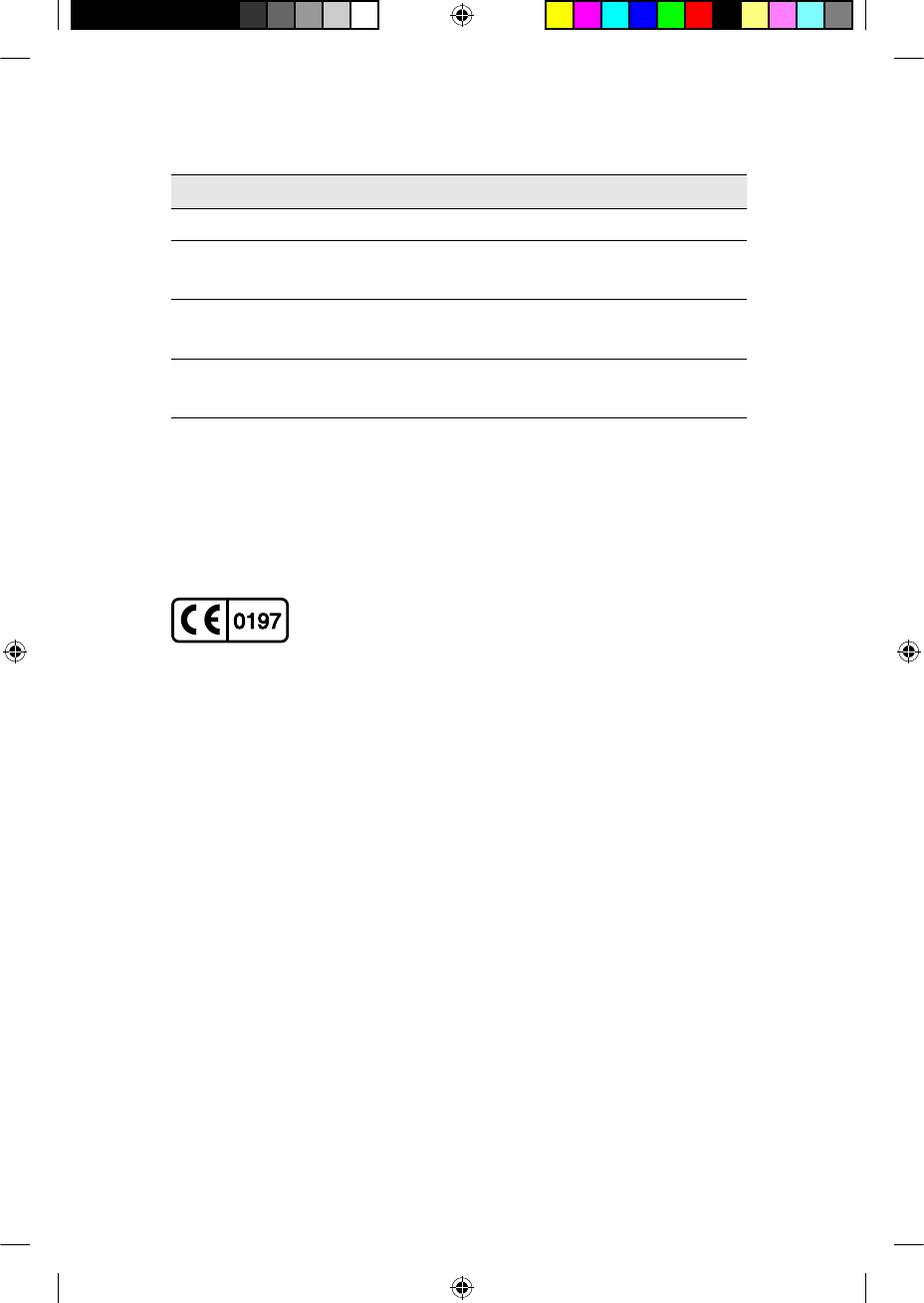
Environmental conditions
Condition Minimum Maximum
Storage temperature -40 ºC (-40 ºF) +50 ºC (+122 ºF)
Storage relative
humidity
0% RH 90% RH
Operating
temperature
+5 ºC (+41 ºF) +50 ºC (+122 ºF)
Operating relative
humidity
0% RH 90% RH
Certifi cation and applied standards
The CR110 Remote Assistant fulfi ls the essential requirements listed in
Annex 1 of the EC directive 90/385/EEC on Active Implantable Medical
Devices as last amended by EC Directive 2007/47/EEC. It was approved
for CE-Mark according to Annex 2 by Notifi ed Body 0197 in 2009.
Equipment classifi cation
Your remote assistant is internally powered equipment Type B as
described in the international standard IEC 60601-1:1988 + A1:1991 +
A2:1995 - Medical Electrical Equipment Part 1: General Requirements
for Safety.
IP rating of remote assistant
The IP rating of the remote assistant is as described in the section
Caring for your remote assistant.
FCC (Federal Communications Commission) and Canadian
IC compliance
This device complies with part 15 of the FCC Rules and with RSS-210 of
Industry Canada. Operation is subject to the following two conditions:
This device may not cause harmful interference.•
© Cochlear Limited 2009 CR110 User Guide - 67
Other information
195993 Iss3 CR110 user guide 01.nu.indd 67 13/05/2009 5:13:32 PM
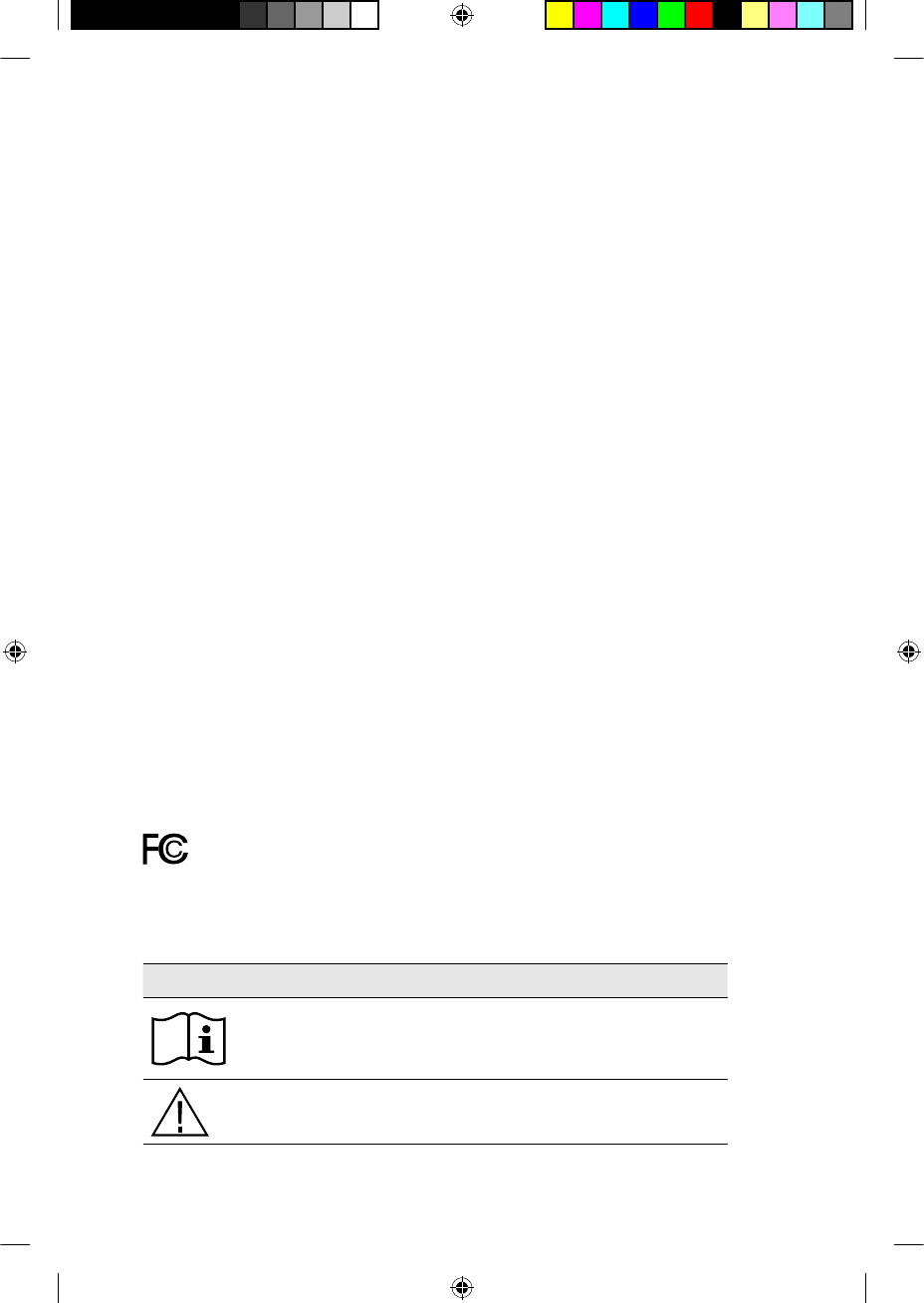
This device must accept any interference received, including •
interference that may cause undesired operation.
Changes or modifi cations made to this equipment not expressly
approved by Cochlear Limited may void the FCC authorization to
operate this equipment.
This equipment has been tested and found to comply with the limits
for a Class B digital device, pursuant to Part 15 of the FCC Rules. These
limits are designed to provide reasonable protection against harmful
interference in a residential installation. This equipment generates, uses
and can radiate radio frequency energy and, if not installed and used
in accordance with the instructions, may cause harmful interference
to radio communications. However, there is no guarantee that
interference will not occur in a particular installation. If this equipment
does cause harmful interference to radio or television reception, which
can be determined by turning the equipment off and on, the user is
encouraged to try to correct the interference by one or more of the
following measures:
Reorient or relocate the receiving antenna. •
Increase the separation between the equipment and receiver. •
Connect the equipment into an outlet on a circuit different from •
that to which the receiver is connected.
Consult the dealer or an experienced radio/TV technician for help. •
FCC ID number: WTOCR11000
IC ID number: 8039A-CR11000
The symbols below are found on your processor components and
packaging.
Symbol Meaning
See Instructions
Refer to warnings and cautions in
related user documentation
68 - CR110 User Guide © Cochlear Limited 2009
Other information
195993 Iss3 CR110 user guide 01.nu.indd 68 13/05/2009 5:13:32 PM
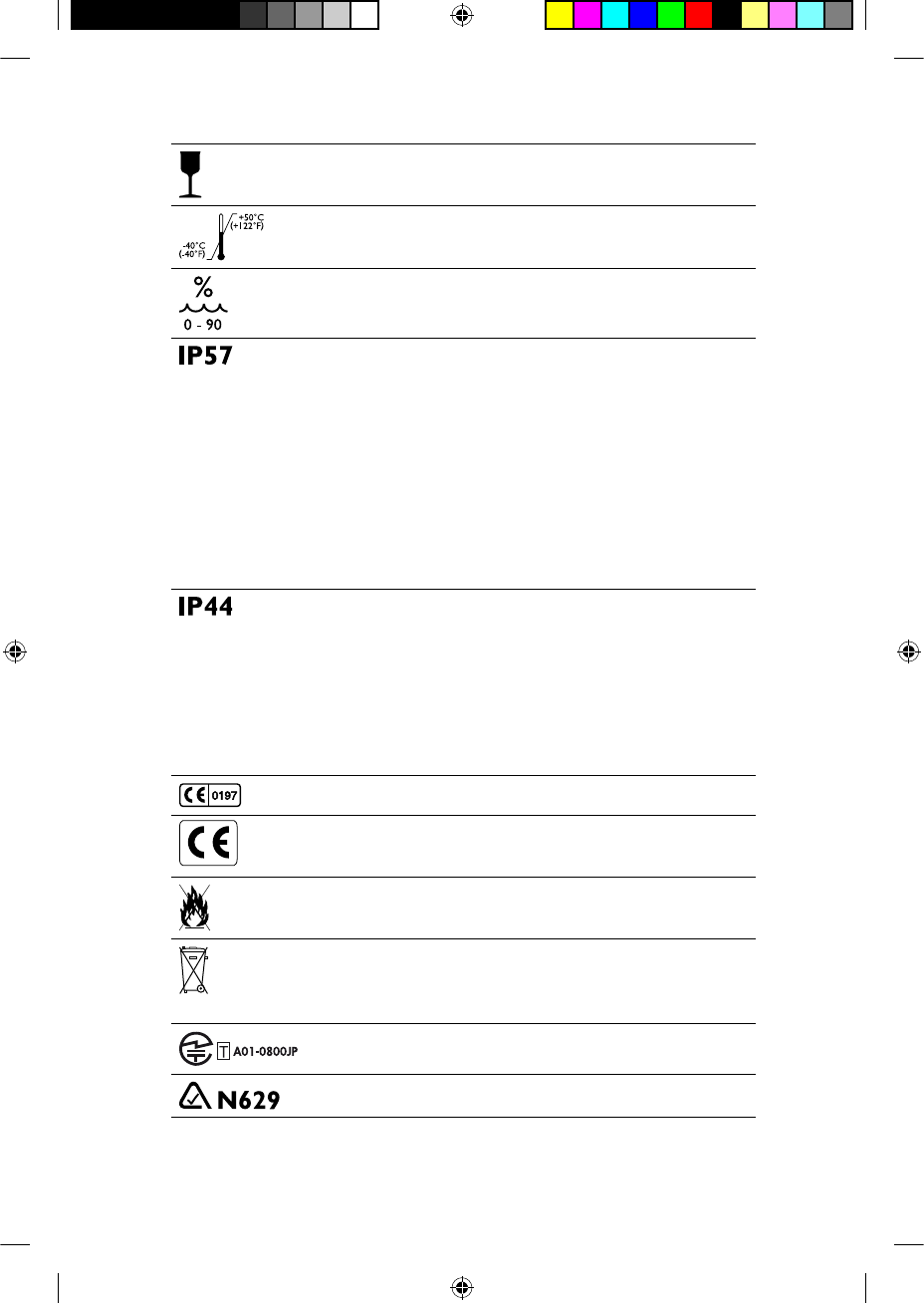
Fragile
Storage Temperature Limits
Relative Humidity Limits
IP Rating
Protected against access of solid
foreign objects greater than or equal
to 1.0 mm diameter.
Protected against failure from
temporary immersion in water.
Protected against failure from dust
penetration.
IP Rating
Protected against access of solid
foreign objects greater than or equal
to 1.0 mm diameter.
Protected against failure from
splashing water.
CE Registration Mark
CE Registration Mark Certifi cation -
Europe
Disposal - do not dispose in fi re
Disposal – dispose of electrical
components in accordance with your
local regulations
Certifi cation - Japan
Certifi cation - Australia
© Cochlear Limited 2009 CR110 User Guide - 69
Other information
195993 Iss3 CR110 user guide 01.nu.indd 69 13/05/2009 5:13:33 PM
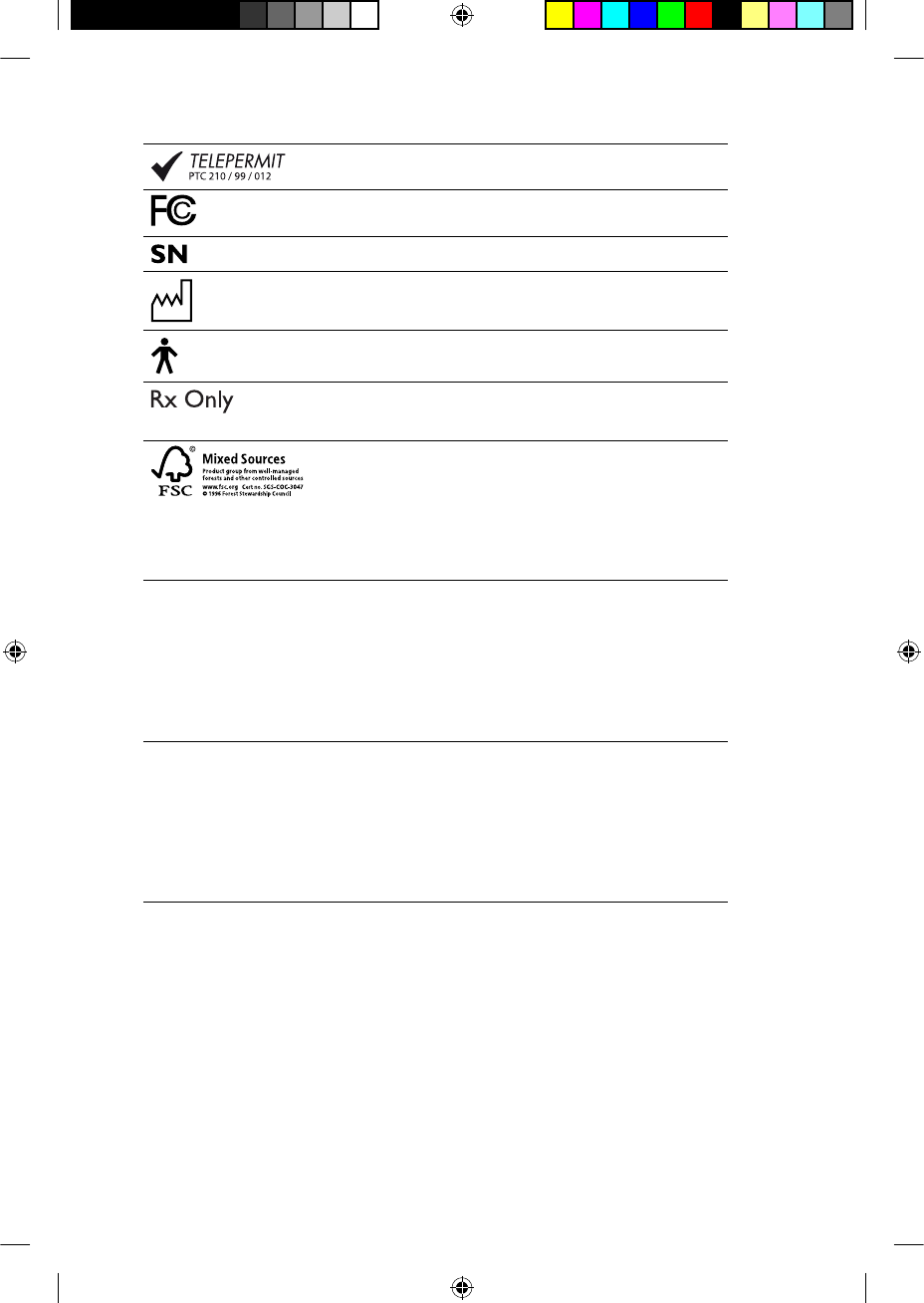
Certifi cation - New Zealand
Tested to comply with FCC standards
Serial number
Date of manufacture
Type B Equipment
This device restricted to sale by or on
the order of a physician.
Mixed Sources - Product group •
for well managed sources and
other controlled sources.
FSC certifi cation only applies to •
cardboard packaging.
CP810 Sound Processor
Cochlear Limited
14 Mars Road, Lane Cove
NSW 2066, Australia
Made in Australia
Product label information for the
sound processor.
CR110 Remote Assistant
Cochlear Limited
14 Mars Road, Lane Cove
NSW 2066, Australia
Made in China
Product label information for the
remote assistant.
Legal statement
The statements made in this guide are believed to be true and correct
as of the date of publication. However, specifi cations are subject to
change without notice.
Nucleus® cochlear implant systems are covered by one or more
international patents.
© Cochlear Limited 2009
70 - CR110 User Guide © Cochlear Limited 2009
Other information
195993 Iss3 CR110 user guide 01.nu.indd 70 13/05/2009 5:13:34 PM

Glossary
Bilateral control The remote assistant communicates
with two processors at the same time.
Cochlear™ Nucleus®
CR100 Series Belt Case
A protective case for the remote
assistant that can be attached to the
belt.
Cochlear™ Nucleus®
CR100 Series Global Power
Adaptor
Connects the remote assistant to
mains power for recharging the
battery.
Cochlear™ Nucleus®
CR100 Series Lanyard
Allows you to wear the remote
assistant around the neck.
Cochlear™ Nucleus®
CR100 Series Leather Case
A protective case for the remote
assistant that you can either attach
to the belt, or carry in the handbag or
pocket.
Cochlear™ Nucleus®
CR100 Series Protective
Case
A protective rubber case for the
remote assistant that is suitable for
use by both adults and children.
Cochlear™ Nucleus®
CR100 Series USB Cable
Cable that connects the remote
assistant to:
USB port of a computer.•
Global power adaptor.•
CP800 Series Battery •
Charger.
Coil sensor Used to check if the coil connected
to the processor is receiving sound
signals from the processor.
Hard reset button Resets the remote assistant if the
Cochlear key is not working.
Home screen Allows access to program selection
and key settings.
Indicator light Provides a visual indication of remote
assistant function status or a problem.
© Cochlear Limited 2009 CR110 User Guide - 71
195993 Iss3 CR110 user guide 01.nu.indd 71 13/05/2009 5:13:35 PM

Left directional key Decrease sensitivity.•
Switch between control modes.•
Change settings.•
Lower directional key Decrease volume or scroll down.
Pairing Allows the remote assistant and
processor to communicate with each
other.
Processor settings menu Allows access and control of specifi c
processor settings.
Processor status screen Displays current processor status.
Remote assistant Hand-held remote control that
controls the Cochlear™ Nucleus®
CP800 Series Sound Processor.
Remote assistant settings
menu
Allows access and control of specifi c
remote assistant settings.
Remote assistant USB
cable socket
Connects the USB cable to the
remote assistant.
Right directional key Increase sensitivity.•
Switch between control modes.•
Change settings.•
Soft keys The four multi-function keys that are
located directly above and below the
remote assistant display.
Toggle button Button on the left spine (side) of the
remote assistant that is used to:
Turn telecoil and Auto •
Telecoil on and off.
Turn audio accessory on and •
off.
Unilateral control The remote assistant communicates
with one processor.
Unpair Unpairs the remote assistant from the
processor.
72 - CR110 User Guide © Cochlear Limited 2009
Glossary
195993 Iss3 CR110 user guide 01.nu.indd 72 13/05/2009 5:13:35 PM

Upper directional key Increase volume or scroll up.
© Cochlear Limited 2009 CR110 User Guide - 73
Glossary
195993 Iss3 CR110 user guide 01.nu.indd 73 13/05/2009 5:13:35 PM

74 - CR110 User Guide © Cochlear Limited 2009
195993 Iss3 CR110 user guide 01.nu.indd 74 13/05/2009 5:13:35 PM

Index
A
Auto Telecoil
automatically turn off 29
switching between using Auto Telecoil and telecoil 29
using 28
B
Belt case
using 57
Bilateral control 51
bilateral screens 51
control modes 52–53
switching between control modes 53
C
Cancelling
cancelling a change to processor settings 45
cancelling a change to remote assistant settings 35
Caring for your remote assistant
cleaning 60
protecting 57–59
using the Lanyard 58–59
warnings and precautions 61
Changing
audio accessory and microphone mixing ratio 42
indicator light preferences 43
microphone direction to Zoom 44
processor settings 40–46
© Cochlear Limited 2009 CR110 User Guide - 75
195993 Iss3 CR110 user guide 01.nu.indd 75 13/05/2009 5:13:35 PM

remote assistant display brightness 47
remote assistant display contrast 46
remote assistant settings 46–49
remote assistant speaker volume 47
sensitivity 25
telecoil and microphone mixing ratio 41
volume 24
Charging battery 11
charging for the fi rst time 11
how to recharge 13
recharging 11
recommended temperature range for charging 12
using the CP800 Series Battery Charger and USB cable 15
using the CR100 Series Global Power Adaptor and USB cable 13
using your computer and USB cable 14
when to recharge 12
Checking
processor battery status 27
processor coil 63
remote assistant battery status 12
Cleaning the remote assistant 60
D
Decreasing
sensitivity 25
volume 24
Demo mode
stop using 37
using 36
76 - CR110 User Guide © Cochlear Limited 2009
Index
195993 Iss3 CR110 user guide 01.nu.indd 76 13/05/2009 5:13:35 PM

Dirt
protection against 59
Disabling
audio and visual alerts 48
private tones 44
Zoom 44
Display
changing the remote assistant display brightness 47
Home screen 22
Displaying program numbers 23
Dual control mode 53
E
Enabling
audio and visual alerts 48
private tones 44
Zoom 44
Equipment classifi cation 67
Everyday program 21
F
FCC compliance 67–68
Focus program 21
H
Hard reset button 38
© Cochlear Limited 2009 CR110 User Guide - 77
Index
195993 Iss3 CR110 user guide 01.nu.indd 77 13/05/2009 5:13:35 PM

Holding the remote assistant 19
Home screen 21
returning to 22
selecting programs 23
I
Increasing
sensitivity 25
volume 24
Indicator lights
meaning 35
Interference
actions to take 20
sources of 20
L
Labelling symbols 68–70
Language selection 49
Lanyard
attaching 58–59
Leather case
using 57
Locking
processor buttons 40
remote assistant keypad 17
78 - CR110 User Guide © Cochlear Limited 2009
Index
195993 Iss3 CR110 user guide 01.nu.indd 78 13/05/2009 5:13:35 PM

M
Microphones
changing direction 44
Mixing ratio
audio accessory and microphone 42
telecoil and microphone 41
Music program 21
N
Noise program 21
O
Operating the remote assistant 19
operating distance 19
P
Pairing the remote assistant
pairing alert screen 30
successful pairing indicator 30–32
unpairing 33–34
when to pair 30
with one processor 30–31
with the second processor 31–32
Personalising processor settings 40
changing the audio accessory and microphone mixing ratio 42
changing the microphone direction 44
changing the telecoil and microphone mixing ratio 41
enabling and disabling private tones 44
locking and unlocking processor buttons 40
setting processor indicator light preferences 43
© Cochlear Limited 2009 CR110 User Guide - 79
Index
195993 Iss3 CR110 user guide 01.nu.indd 79 13/05/2009 5:13:35 PM

viewing processor fi rmware and serial number 45
Personalising rem ote assistant settings 46
changing the rem ote assistant display brightness 47
changing the rem ote assistant display contrast 46
changing the rem ote assistant speaker volum e 47
enabling and disabling audio and visual alerts 48
selecting the rem ote assistant language 49
view ing the rem ote assistant fi rm w are and serial num ber 49
Personalising settings 39
personalising processor settings 40
personalising rem ote assistant settings 46
Processor indicator lights
setting preferences 43
Program s
display program num bers 23
Everyday 21
Focus 21
M usic 21
N oise 21
selecting 23
Protecting the rem ote assistant 57–58
Protective case
using 58
R
Recharging battery 11
80 - CR110 User Guide © Cochlear Lim ited 2009
Index
195993 Iss3 CR110 user guide 01.nu.indd 80 13/05/2009 5:13:35 PM

Remote assistant 7
components 9–10
dimensions 66
fi rmware and serial number 49
holding 19
H ome screen 21
indicator lights 35
locking and unlocking 17
materials 66
operating 19
operating characteristics 66
physical confi guration 65–66
resetting settings 35
selecting language 49
specifi cations 65–66
turning on and off 16
using 19
Resetting
processor settings and programs 45
remote assistant settings 35
S
Selecting programs 23
Selecting the remote assistant language 49
Sensitivity
decreasing 25
increasing 25
Switching
between Auto Telecoil and telecoil 29
between bilateral control modes 53
© Cochlear Limited 2009 CR110 User Guide - 81
Index
195993 Iss3 CR110 user guide 01.nu.indd 81 13/05/2009 5:13:35 PM

T
Technical information
environmental conditions 67
specifi cations 65–66
Telecoil
reducing background noise 28
turning off 28
turning on 28
Troubleshooting the processor 63
Turning the remote assistant on and off 16
U
Understanding remote assistant indicator lights 35
Unlocking
processor buttons 40
remote assistant keypad 17
Unpairing the remote assistant 33
Using
Auto Telecoil 28
belt case 57
Demo mode 36
lanyard 58–59
leather case 57
protective case 58
remote assistant 19–20
telecoil 28–29
the remote assistant to troubleshoot the processor 63–64
82 - CR110 User Guide © Cochlear Limited 2009
Index
195993 Iss3 CR110 user guide 01.nu.indd 82 13/05/2009 5:13:35 PM

V
View
processor fi rmware number 45
remote assistant fi rmware number 49
Visual alerts 63
Volume
decreasing 24
increasing 24
W
W arranty 65
W ater
protection against damage 59
© Cochlear Limited 2009 CR110 User Guide - 83
Index
195993 Iss3 CR110 user guide 01.nu.indd 83 13/05/2009 5:13:35 PM

Notes
84 - CR110 User Guide © Cochlear Limited 2009
195993 Iss3 CR110 user guide 01.nu.indd 84 13/05/2009 5:13:35 PM

Notes
© Cochlear Limited 2009 CR110 User Guide - 85
195993 Iss3 CR110 user guide 01.nu.indd 85 13/05/2009 5:13:36 PM

Notes
86 - CR110 User Guide © Cochlear Limited 2009
195993 Iss3 CR110 user guide 01.nu.indd 86 13/05/2009 5:13:36 PM

195993 Iss3 CR110 user guide 01.nu.indd 87 13/05/2009 5:13:36 PM
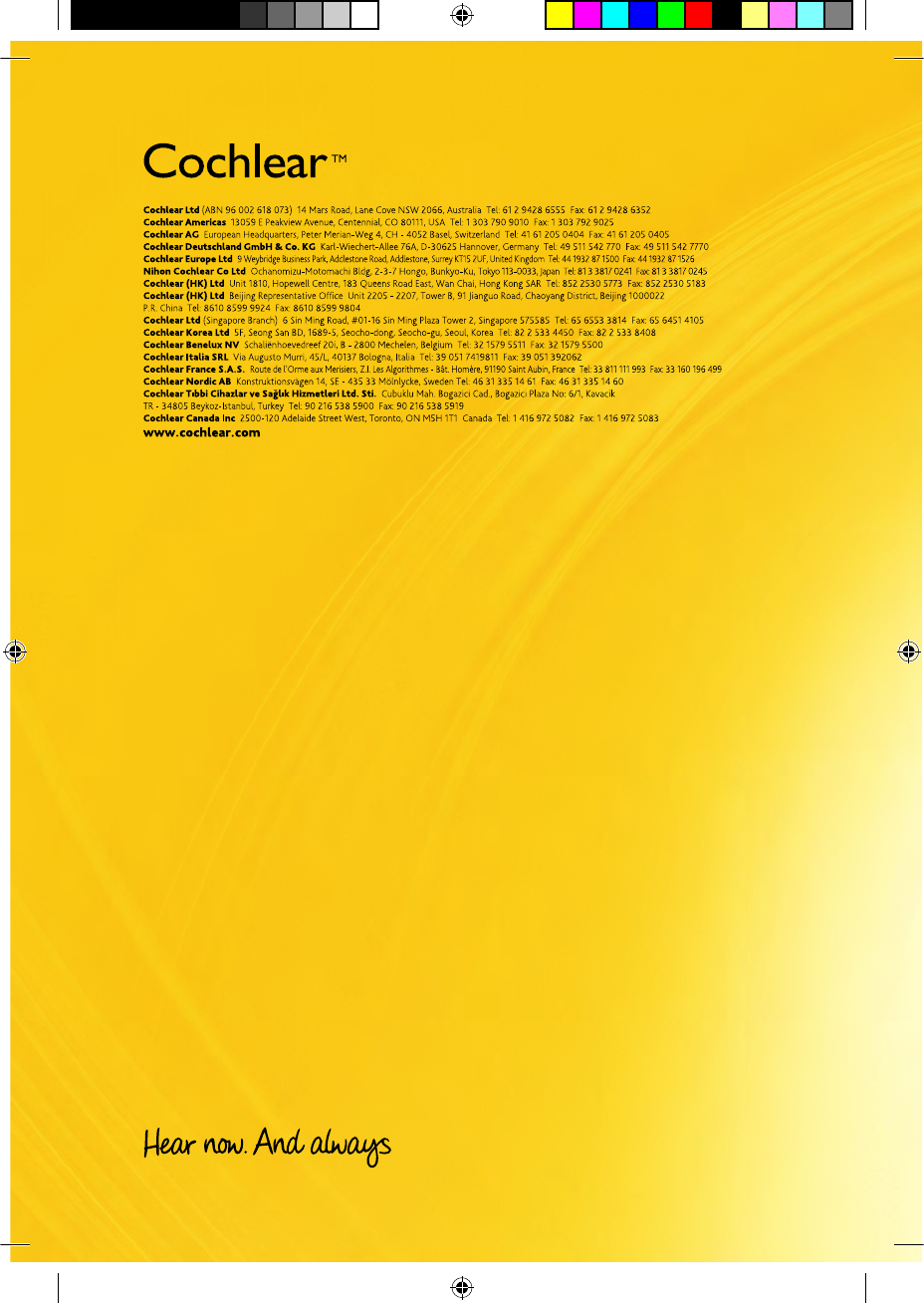
Nucleus is a registered trademark of Cochlear Limited.
Cochlear and the elliptical logo and Freedom are trademarks of Cochlear Limited.
The statements made in this guide are believed to be true and correct in every detail as of the date of publication. However,
specifi cations are subject to change without notice.
Printed in Australia
195993 ISS3
Front and back cover CR110 Iss 3 01.indd 2 13/05/2009 5:30:18 PM